Ancient Western Asian Seals & Tablets
The Morgan's seals collection is one of the most distinguished in the United States and among the best known in the world. Generally only an inch in height, engraved seals are among the smallest objects ever produced by sculptors. They were carved in great detail with simple tools on semiprecious stones. These engraved objects provide a continuous artistic and chronological sequence of more than three thousand years. The seals collection covers all the significant styles of Mesopotamian engraving from the end of the fifth millennium B.C. to the fourth century B.C. as well as most of the styles of other countries of ancient Western Asia. Areas of particular strength include seals of the second millennium B.C. made outside southern Mesopotamia (Cappadocia, Syria, and Mitannia) as well as Old Babylonian and Neo-Assyrian seals. The Middle Assyrian seals are among the finest in any collection.
Pierpont Morgan collected nearly three thousand cuneiform tablets, the bulk of which are now in the Yale Babylonian Collection, which he founded. The Morgan's collection also includes cuneiform tablets and a few outstanding art objects from ancient Western Asia.
Between 1885 and 1908, the American collector William Hayes Ward assembled, probably on Pierpont Morgan's behalf, a collection of 1,157 seals. This became the core of the Morgan's holdings. Two additional major gifts—the collection of Robert F. Kelley, given by his sister Caroline M. Burns in 1977, and that of Jonathan P. Rosen, a study collection, given in 1986—have enhanced the Morgan's holdings in this area.
Ancient Western Asian seals on display in The North Room of J. Pierpont Morgan's Library »
We acknowledge with grateful thanks Jeannette and Jonathan P. Rosen's generous underwriting support for the activities of the Department of Ancient Western Asian Seals and Tablets.
Stone Bowl With a Dedication Inscription in Sumerian
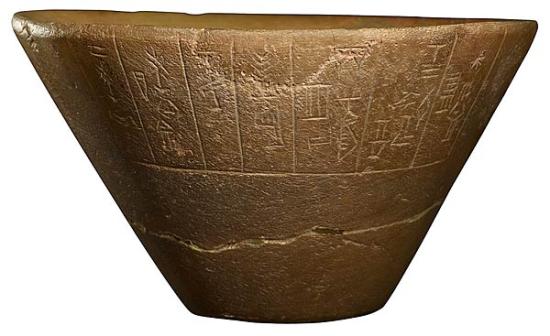
Stone Bowl With a Dedication Inscription in Sumerian
Inscribed: (To) [a deity], Megirimta, child born to Lugal-kisalsi (and) wife of Muni-hursag, presented (this bowl).
It is not certain whether the Lugal-kisalsi mentioned in the inscription was the king of Uruk of that name because the inscription states only his name. Whatever his position, Lugal-kisalsi's daughter must have been highly placed because the stone vessel that she dedicated belongs to a type of object valued and preserved over many centuries. The stone was probably imported from the northern mountain chains of Iran, which are thought to have been the source of the materials for the stone vessels excavated at the site of Uruk in southern Mesopotamia, where this bowl was found before 1904.
Foundation Figure of a Kneeling God Holding a Peg
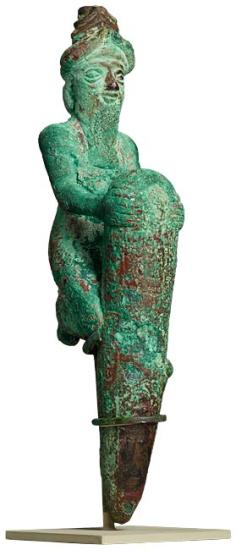
Foundation Figure of a Kneeling God Holding a Peg
Purchase
This well-preserved copper figurine is a god, identifiable as such by his headgear, topped by several pairs of bull's horns. He is symbolically "nailing" the foundation of the temple permanently to the earth. The sculptor vested a figure, fully realized in the round, with an inherent naturalism and delicate fluidity. Though immobilized by the act depicted, the muscular interaction of his body parts is well understood. By analogy with earlier inscribed foundation figures, the deity probably represents the personal god of Gudea, ruler of Lagash.
Foundation Figure of King Ur-Namma
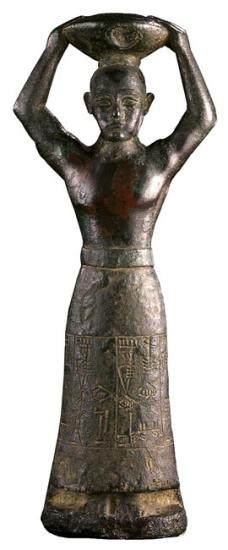
Foundation Figure of King Ur-Namma
Inscribed: Ur-Namma, king of Ur, king of Sumer and Akkad, the one who built the temple of Enlil.
The first king of the Third Dynasty of Ur, Ur-Namma was responsible for the restoration of old temples and oversaw the extensive construction of new temples and stepped temple towers known as ziggurats. The figure depicts the king with his head and face shaved, his torso nude, and wearing a long skirt. On his head he carries a basket containing the mud to make the temple's bricks. The first one was molded by the king himself, who is represented in the occupation considered the lowliest in Mesopotamia—"carrying the basket"—for in the presence of the gods the king was a humble servant. The skirt is inscribed with his titles and achievements, Ur-Namma, king of Ur, king of Sumer and Akkad, the one who built the temple of Enlil. He is shown in an act of deep piety, and the sculpture gives us a rare glimpse of royal portraiture by first-rate metropolitan craftsmen of the twenty-first century B.C.
Stone Foundation Tablet Sumerian
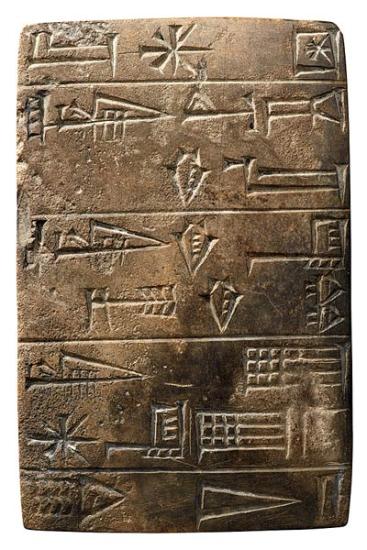
Stone Foundation Tablet Inscribed With the Name and Titles of King Ur-Namma in Sumerian
Inscribed: Ur-Namma, king of Ur, king of Sumer and Akkad, the one who built the temple of Enlil.
The first king of a new dynasty, Ur-Namma was responsible for the restoration of old temples and oversaw the extensive construction of new temples and stepped temple towers known as ziggurats. The tablet was part of the regular foundation deposit of Ur-Namma together with a bronze figure of the king as a basket carrier. Such deposits were meant to record the pious works of the royal builders for the deities to whom the temples were dedicated. Later rulers digging up the foundations of earlier temples— always on the same hallowed ground—would treat the inscriptions of their predecessors with respect.
Tablet Inscribed in Akkadian
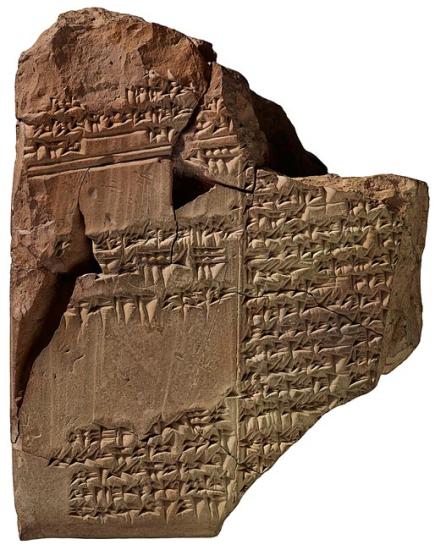
Tablet Inscribed in Akkadian with a Fragment of the Babylonian Flood Story of Epic of Athrasis
The precious fragment is the earliest known Akkadian version of the familiar Noaj motif. The epic begins with the creation of man when "great indeed was the drudgery of God." So the gods created man but soon tired of him and decided to destroy all of mankind. The god Enki(Ea) tells Atrahasis of the impending flood and instructs him to build an ark. With over 1,200 lines, the story filled three tablets. The Morgan fragment, from the second tablet, or chapter, preserves a unique colophon, stating the work's title—"When Gods Were Men"—as well as the name of the scribe and the place and date upon which he copied it.
(The god) Enki made his voice heard...
Dismantle the house, build a boat
Reject possessions, and save living things.
The boat that you build...
Make upper and lower decks.
The tackle must be very strong,
The bitumen strong, to give it strength
I will make rain fall on you here.
The Flood roared like a bull,
Like a wild ass screaming the winds
The darkness was total, there was no sun...
For seven days and seven nights
The torrent, storm and flood came on...
Archer attacking lion-griffin
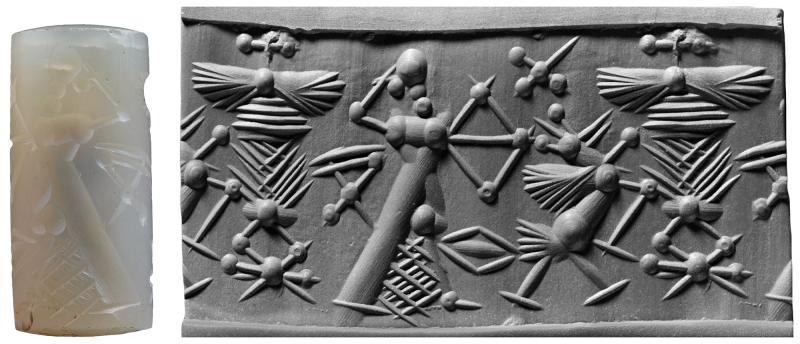
"Some late drilled-style cylinders have contest scenes (719-723). Seals 719 and 720 present a cursory rendering of the archer pursuing a lion-griffin, as in 689, which belongs to the linear syste, and 690, which is of early drilled style."--Porada, CANES, p. 86
Archer in assault on lion-griffin menacing tree that has winged sun disk above it; before archer, rhomb; behind him, table -- Cross-shaped object in sky.
Attendant waving palm whisk over table before seated king

"The central element of the ritual scenes of 770-775 is the sacred tree. In these designs it is rendered in three different ways, namely: with graceful streamers and volutes (770); within the net of lines that may connote irrigation canals surrounded by shoots (772, 773); and realistically as a palm tree (774, 775)... In 774 and 775 the tree, while still the central element, possibly appears in the scene merely because it is somehow related to the deities pictured beside it...Seals 770-777 may with certainty be classified as Neo-Assyrian cylinders of the latter part of the eight and of the seventh century.... The robe of the worshiper in 775 suggests Babylonian influence in that it has folds at the back as in garements seen on Neo-Babylonian seals..., and in that the fringe appears only at the bottom of the robe instead of being drawn over the hip as in earlier Assyrian representations like 644. The attendants in 776 are similarly clothed, suggesting that both 775 and 776 were made in or after the time of Sargon, when marked Babyylonian influence modified even the type of dress worn at court."--Porada, CANES, p. 93-94
Attendant waving palm whisk over table decked with cloth and cup before seated king(?) raising cup -- Behind king, second attendant with fan and towel -- In sky, wedge, winged sun disk, star, crescent.
Banquet scene with seated figures drinking from tubes
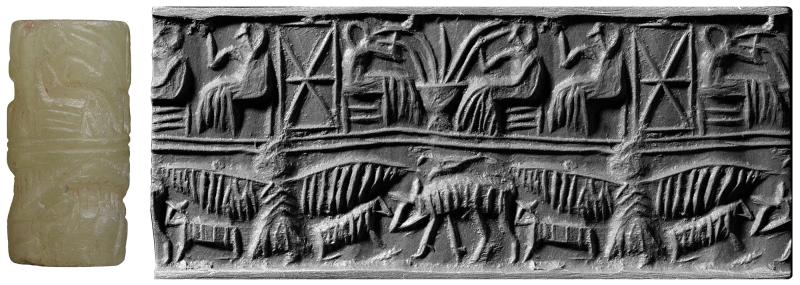
"Seals 105 and 106... and perhaps also 107 and 112, belong to the Second Early Dynastic period... In the lower register of 112, the monster whose tail ends in a scorpion recalls the composite monsters of the Second Early Dynastic period; a dating in this period is also indicated by the linear execution of the design." Porada, CANES, p. 16
Above: Two seated figures drinking from tubes in vessel; third seated figure -- Below: Eagle, lion-headed(?), between two small kneeling animals; large walking animal with tail ending in scorpion. No common axis of scenes of upper and lower register.
Bearded hero with daggers and two ibexes
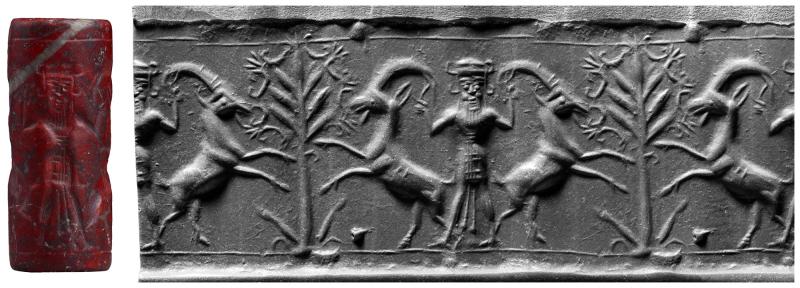
"Palm trees marked with volutes are found in 596 and 597. This use of volutes recalls Mitannian designs, though in the latter the tree as a whole always conveys an impression of artificiality, whereas on the Middle Assyrian seals it has the appearance of a natural tree merely ornamented with metal bands." Porada, CANES, p. 69
Bearded hero (full face), dagger in each hand, standing between two ibexes that jump away from him, each toward tree that is flanked by them as scene repeats.
Brocade style design with running goats and other animals
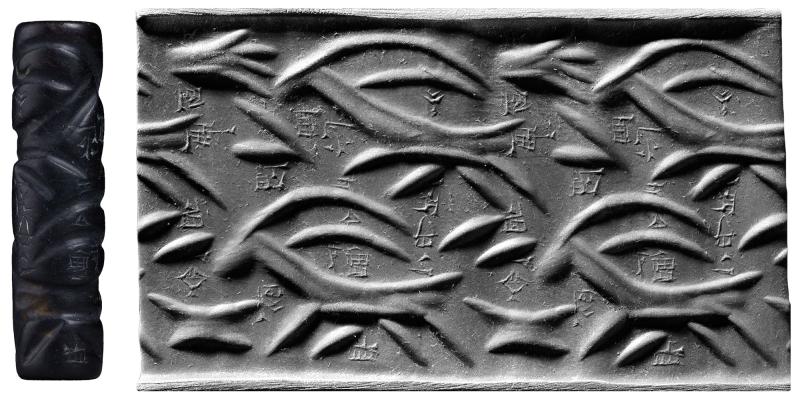
Pattern with two running goats one above other, simplified animal, bird or fish, two lines forming angle.
Bull walking
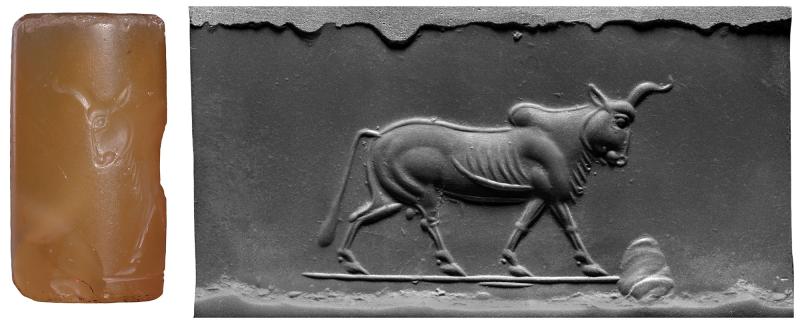
"Seal 837 recalls Greek gems of the fifth century in its exquisite engraving and spacious background. It can be dated in that period by analogy with a seal impression on a tablet of the time of Darius and Xerxes (Philadelphia 833)."--Porada, CANES, p. 104
Bull walking.
Bull with tail grasped by griffin-demon

"Dating of 594 in the fourteenth century is indicated by its similarity to a seal impression of that time (Weber 316a). In each instance a decorative motif is formed by using thw ings of the lion-griffins to frame a palmette tree. In the scene of the impression the shoulder feathers of the lion-griffin's wings are indicated by drillins. This distinctive detail (which appears to derive from Mitannian designs), though it is lacking in 594, does appear in 595. Furthermore, the delicate modeling of the latter seal indicates that it belongs to the fourteenth-century group of Middle Assyrian cylinders. It may be noted that in 595 the tip of the second horn of the bull is indicated; thus the bull's head is shown in a quasi three-quarter view. While such three-quarter profiles remain unparalleled in Mesopotamian designs, they occur frequently in contemporary Aegean art." Porada, CANES, p. 68
Walking bull with its tail grasped by griffin-demon on one knee, whose other hand touches same bull, thus initiating repetition of scene -- In field, inscription.
Captive led by warrior facing kneeling captive and enemy soldier

"Though Greek soldiers appear in the battle scene of 833, the arrangement of the figures in a row and their rigid postures reflect Mesopotamian tradition rather than Greek influence."--Porada, CANES, p. 104
Captive led by warrior who faces second, neeling captive and enemy soldier whom he is spearing -- In field, Aramaic inscription.
Centaur attacking winged bull
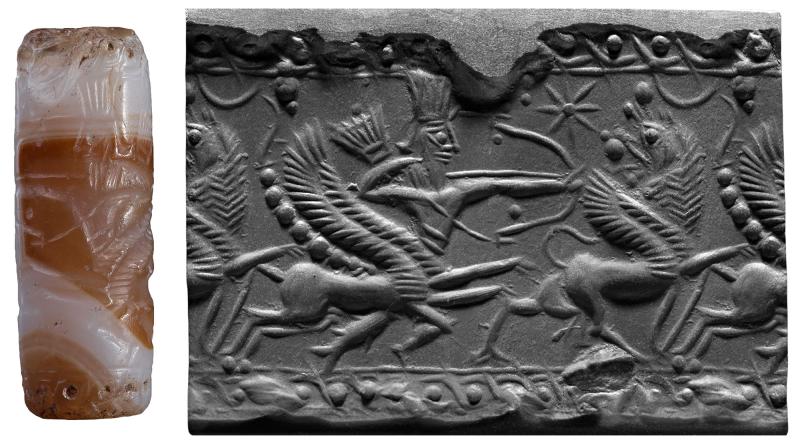
"The earlier group (747-752), comprising cylinders for which a Neo-Babylonian classification is suggested, seems to reflect influence of the Middle Assyrian modeled style, while the later group (753-769) illustrates the specific character of the Neo-Assyrian modeled style of the late eighth and of the seventh century B.C., though in some cases a seal included in this grouping may have been made in Babylonia."--Porada, CANES, p. 90
Centaur with bow and arrow attacking winged lion -- In field, star, crescent, fish (below centaur), scattered globes -- Borders of scroll pattern with drillings, blossom composed of globes pendant from upper border.
Charging bull

"In 635 and 636, the principal figure is a bull. In 635 the animal is charging at a rosette; this theme probably represents an abbreviation of such contest scenes as that of 618. Since the renderings of the bull in 635 and 618 are almost identical, a dating in correspondence with that of the latter seal, in the ninth or in the earlier part of the eighth century, is indicated for 635."--Porada, CANES, p. 75
Charging bull, rosette before it -- Seven globes in sky.
Contest frieze
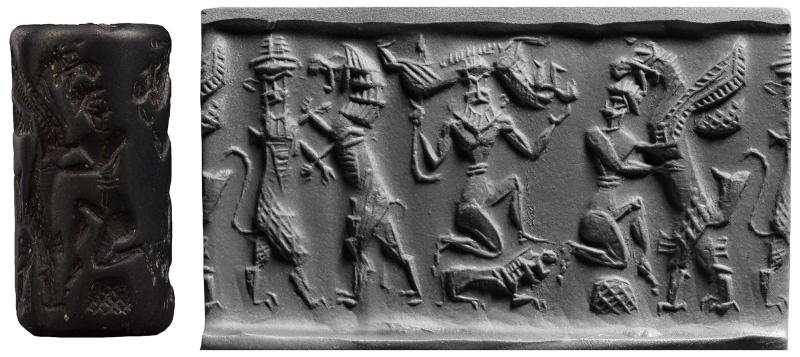
"... while the arrangement of the Old Babylonian contests is similar to that used in the earlier period, the introduction of new figures, especially in 359-369, indicates that such ontests had acquire new significance. The new figures include a goat seated upright on a knoll and attacked by a lion or lion-griffin or both, and a man on one knee at the mercy of similar assailants." Porada, CANES, p. 44
Bull-man fighting lion; nude bearded hero on one knee, poised on back of second lion and holding third lion behind his head; man on one knee on knoll, with lion-griffin attacking.
Contest frieze with bull and nude bearded hero; bull-man and lion

Damaged cylinder.
"In the seals of mature Akkad style, the theme of contest between heroes and beasts is embodied in two pairs of fighting figures flanking a central design or the panel of an inscription. A characteristic detail of the resulting rather formal composition is the lozenge effect produced by the arms of the fighters and the legs of their victims. The nude bearded hero and the bull-man are the most common protagonists in these contests, but figures attired like human huntsmen often take the place of the nude bearded hero (165) or of both fighters (166, 169). In other instances two identical bull-men (167) or nude bearded heroes (168) are represented. Water buffaloes and lions are the most frequent opponents of the heroes. In these seals of mature Akkad style, lions are almost always shown in profile. The scene of 170, showing a figure pouring a libation beside the two fighting pairs, is exceptional." Porada, CANES, p. 22
Bull subdued by nude bearded hero -- Bull-man overpowering lion -- Between contestant pairs, inscription -- Terminal: Kneeling mouflon.
Contest frieze with bull-men fighting lions
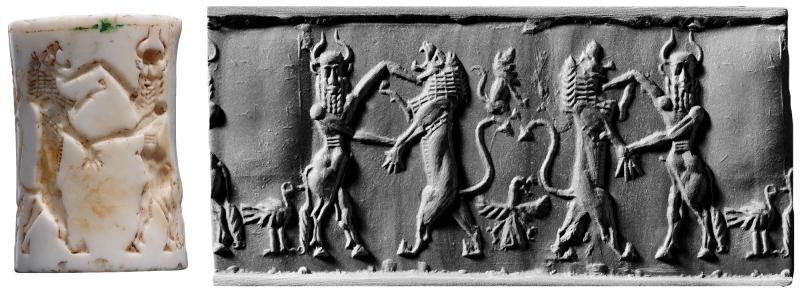
"In the seals of mature Akkad style, the theme of contest between heroes and beasts is embodied in two pairs of fighting figures flanking a central design or the panel of an inscription. A characteristic detail of the resulting rather formal composition is the lozenge effect produced by the arms of the fighters and the legs of their victims. The nude bearded hero and the bull-man are the most common protagonists in these contests, but figures attired like human huntsmen often take the place of the nude bearded hero (165) or of both fighters (166, 169). In other instances two identical bull-men (167) or nude bearded heroes (168) are represented. Water buffaloes and lions are the most frequent opponents of the heroes. In these seals of mature Akkad style, lions are almost always shown in profile. The scene of 170, showing a figure pouring a libation beside the two fighting pairs, is exceptional." Porada, CANES, p. 22
Two contestant pairs, each consisting of bull-man fighting lion -- Between contestant pairs, inscription (erased) -- In field (later additions): Standing bird, seated lion, eagle with spread wings.
Contest frieze with demon and lions

"Though the composite monsters of 57-59 may be mythological, it is possible that the merging of human and animal forms derived from a desire of the artist to maintian the essential symmetry and compactness of the composition as a whole." Porada, CANES, p. 9
Three demons, whose legs are foreparts of merged lions, postured as holding latter by their tails, which end in serpent heads. Middle demon rendered full face, his hair indicated by short lines; other demons in profile, demon at right having upright curls.
Contest frieze with feather-crowned hero and bull; nude bearded heros and human-headed bulls
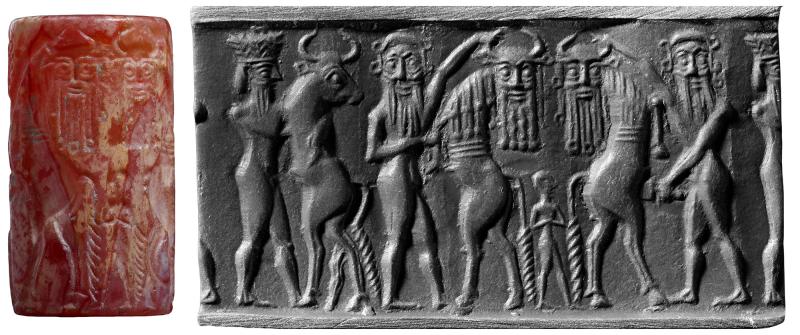
"In the seals deriving from the beginning of the Akkad period, the Early Dynastic frieze of closely interwoven figures gradually breaks up into two or three groups of contestants. Frequently a symetrical effect is obtained by a duplication of the human-headed bull (147-52, 154). These scenes... show the lack of cohesion in composition that is characteristic of Early Akkad seals. Equally characteristic is the more developed modeling of the figures. Lastly, a number of details serve to distinguish this class of seals: the attitudes of the heroes and of the bull-men, who often show a characteristic flexion of the elbow in reaching toward the top of the victim's head; the lion's head frequently seen from above, as in the representations of the Third Early Dynastic period; the attire of the heroes, most often plain or fringed kilts, with flat caps or feather crowns appearing in several instances."--Porada, CANES, p. 21
Feather-crowned hero grasping bull -- Two nude bearded heros each holding one of two human-headed bulls -- Small man between the human-headed bulls.
Contest frieze with heros, bull, mouflon, and lion

"The heros in the contests often, as in 52, wear flat caps as well as skirts tucked up above the knee to provide freedom of movement. The fact that in a contemporaneous limestone inlay from Kish a king is similarly attired shows that such caps and skirts were characteristic of the Second Early Dynastic period." . Porada, CANES, p. 9-10
Hero grasping bull and mouflon -- Latter menaced by lion which is attacked by second hero with dagger.
Contest frieze with horned deity, lion, and nude hero
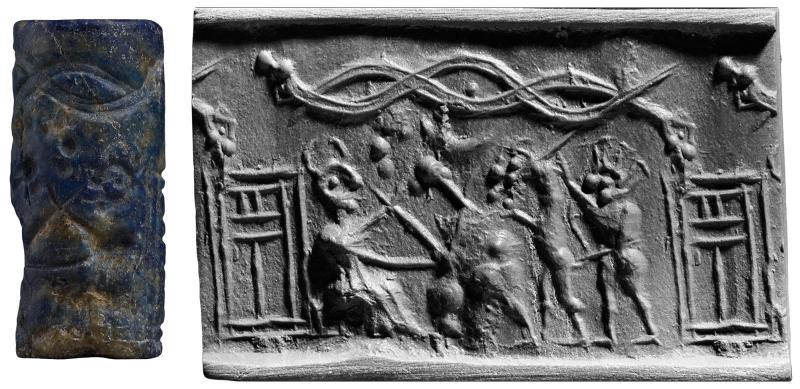
"The theme of 62, in which a hero and a lion--both figures of the contest frieze--take part in the main scene, has been interpreted by Frankfort as representing the god of fertility seated before his temple. The classification of this seal is not quite certain, because the engraving shows an application of the drill that is unusually pronounced for this period." Porada, CANES, p. 11
Horned deity (?) seated before shrine and drinking through tube from vessel -- Human figure prevented from drinking by lion, which is attacked by nude hero with upturned curls -- Above the vessel, globes(?) and crescent moon -- In sky, two entwined lion-headed snakes, one touching shrine with its head.
Contest frieze with leopard, horned animal, lions, bull, and bull-man

"Seals 74-77, which show a treatment of the frieze similar to that in 73, may be assigned to the same time." Porada, CANES, p. 13
Leopard attacking horned animal that is assailed by one of two crossed lions, second of which attacks bull held by bull-man -- Between arms of latter, small feline head -- Terminal: horizontals with scorpion above and two small crossed animals below.
Contest frieze with lion-armed demon

Upper edge of cylinder chipped.
"Equally distinctive of this age is the two-pointed headdress seen in 60 and 61 and rendered on a larger scale in an alabaster plaque from Fara... In 61 the composite monster with two-pointed headdress is comparable to the composite figures in the contest friezes of the Second Early Dynastic period, as found in 59. Though the meaning of this monster, as well as that of the rest of the scene, is enigmatic, the arrangement of the figures and their strange actions suggest that the scene may be connected with some mythological concept." Porada, CANES, p. 10-11
Lion-armed demon with human torso and legs and two-pointed headdress, vase on his raised leg, dagger against his bent leg -- Before him, two large scorpions; above one, small figure seated on chair; above other, two crossd lions and small scorpion on platform
Contest frieze with nude hero, leopard, stag, a hero with upturned curls, mouflon, and lion

"Seals 80-84 probably originated in the same time [as Seal 78], since the small figures on these seals are in the same style as those on the impression of the seal of Barnamtarra, Lugalanda's wife." Porada, CANES, p. 13
Nude hero with dagger and curved weapon attacking leopard that menaces stag -- Latter clasped by hero with upturned curls who also clasps mouflon assailed by lion -- In field: inscription.
Contest frieze with water buffalo and nude bearded hero; bull-man and lion
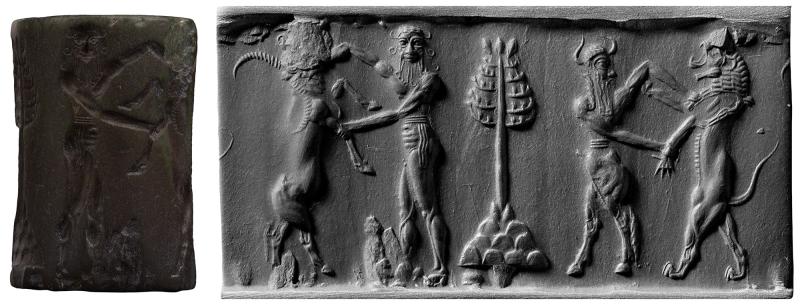
"In the seals of mature Akkad style, the theme of contest between heroes and beasts is embodied in two pairs of fighting figures flanking a central design or the panel of an inscription. A characteristic detail of the resulting rather formal composition is the lozenge effect produced by the arms of the fighters and the legs of their victims. The nude bearded hero and the bull-man are the most common protagonists in these contests, but figures attired like human huntsmen often take the place of the nude bearded hero (165) or of both fighters (166, 169). In other instances two identical bull-men (167) or nude bearded heroes (168) are represented. Water buffaloes and lions are the most frequent opponents of the heros. In these seals of mature Akkad style, lions are almost always shown in profile. The scene of 170, showing a figure pouring a libation beside the two fighting pairs, is exceptional." Porada, CANES, p. 22
Water buffalo subdued by nude bearded hero --Bull-man fighting lion -- Between contestant pairs, tree on knoll.
Contest scene with kilted hero, bull, lions, and reversed feline
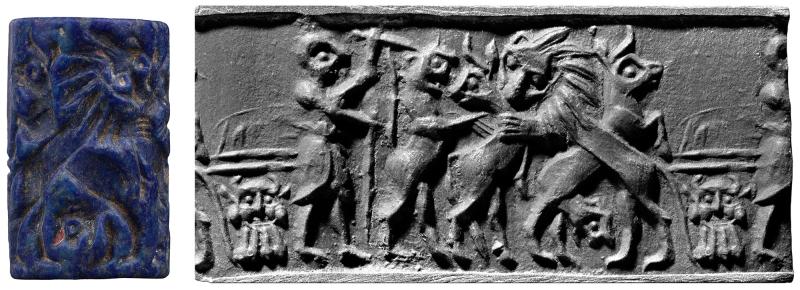
Kilted hero with dagger and stick attacking feline -- Latter attacking bull that is also assailed by lion crossed with bull whose lower parts are merged with reversed feline -- Terminal: horizontals with empty space above and head of human-headed bull below.
Eagle above undulating crosshatched line
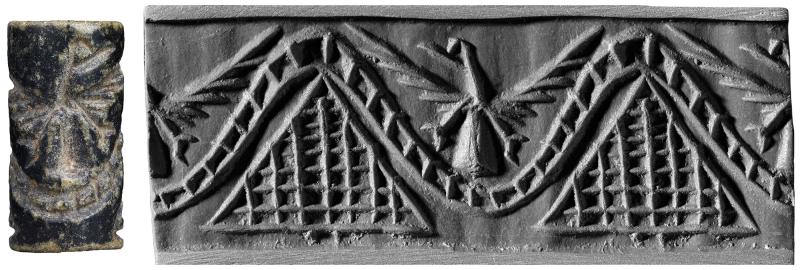
"Seals 264-266, each of which presents a frieze with an eagle in the center, are characterized as Post-Akkad stones by their deeply incised engraving. Moreover, the eagle in 264 and 265 corresponds with a similar figure in Berlin 247, a seal showing in its lower register the birds found to be distinctive of Post-Akkad cylinders (258, 260)." Porada, CANES, p. 32
Undulating crosshatched line with eagle above and crosshatched triangle below.
Enthroned goddess with mace, worshiper with kid pouring libation on altar, and two female worshipers
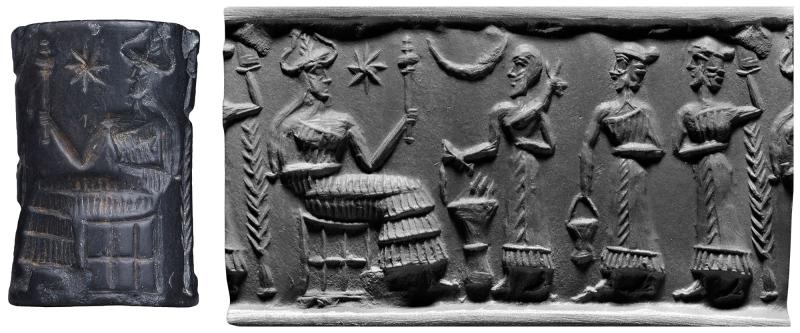
"Scenes showing worshipers standing before a deity without an intermediary (245-247) are rare in this period and later." Porada, CANES, p. 30
Enthroned goddess with mace facing worshiper who carries kid and pours libation over flaming altar -- Behind worshiper, two female worshipers, one with pail, other with arm upraised supporting object on palm of her hand -- Star and crescent in sky -- Terminal: plant.
Ewe and ram flanking plant

"The theme of 5 is related to that of 2 by the fact that a ram and ewe, probably representative of a larger herd, are pictured with a symbol. This symbol, interpreted by Andrae as a gatepost with streamers, has been identified as the symbol of the mother goddess, since it can be shown to have developed into the name sign of Inanna, a deity who appears as a mother goddess in religious texts of later periods." Porada, CANES, p. 3
Cylinder partially perforated.
Ewe and ram flanking plant -- Terminal: post with streamer.
Female and male attendants with banqueters
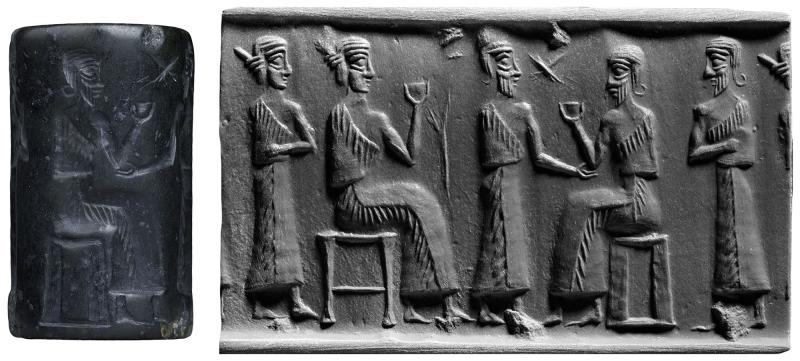
"Banquet scenes, which occur so frequently on Early Dynastic seals, are found on only a few Akkad cylinders. In the latter the banqueting figures are occasionally identified as deities by their horned miters (248, 249), whereas in the earlier renderings the character of the figures remains undetermined. Even in 250, in which the figures do not wear horned miters, they are characterized as superior beings by their seats: the female personage sits on a stool fashioned with what appear to be bull's legs, the male personage on a throne shaped like a shrine." Porada, CANES, p. 30
Female attendant behind seated woman raising cup, male attendant supporting elbow of man seated opposite, likewise raising cup -- Second male attendant at right.
Female worshiper with pail and male worshiper with kid being led by minor god toward sun god with rays
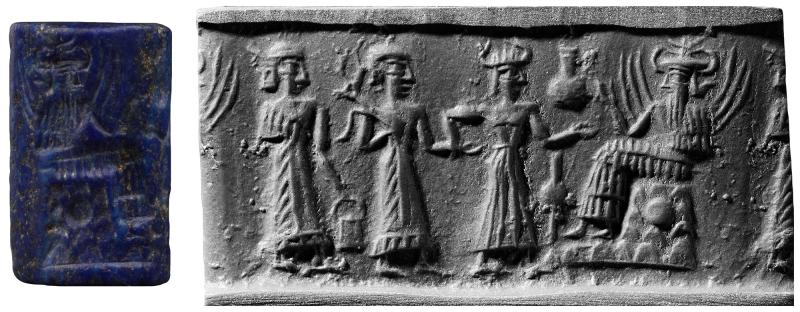
"Among the mythological figures on Akkad seals, the most frequent is the sun god, Shamash. One of the distinctive settings in which this god appears is found in 178-186. The god, identified by his saw and usually by rays emanating from his shoulders, is shown in ascending posture either between two mountains, placing his foot on one and resting his hand on the other, or beside a single mountain on which he steps while resting his hand on a mace. Before him attendants throw open the gates of heaven... Worshipers are sometimes found on seals featuring the ascending sun god, as in 184 ... Hovever, figures approaching the god appear more frequently when he is enthroned than when he is ascending a mountain. Such figures may be human or divine worshipers (189-194)." . Porada, CANES, p. 24
Female worshiper with pail following male worshiper who carries kid and is being led by minor deity toward sun god with rays enthroned on mountain -- Before sun god, vessel and ball staff.
Figure holding up bull by hind leg
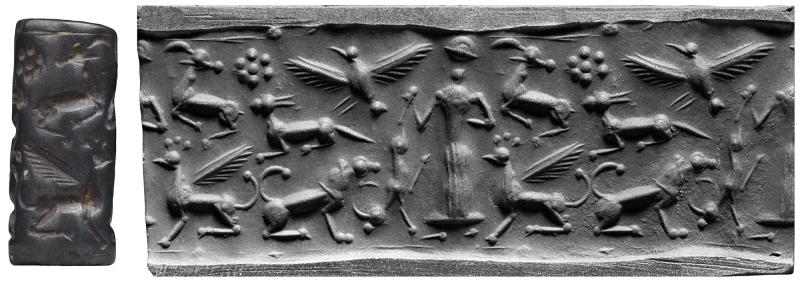
"In 1040, the figure holding up an animal by the hind leg may be a deity, associated with hunting."--Porada, CANES, p. 145
Figure holding up bull by hind leg -- In field: above, kneeling antelope, rosette, kneeling gazelle, bird -- Below, griffin, lion.
Figure with scimitar

Figure with scimitar -- Behind figure, fly -- Inscription.
God holding rod and ring with feet on kneeling bull
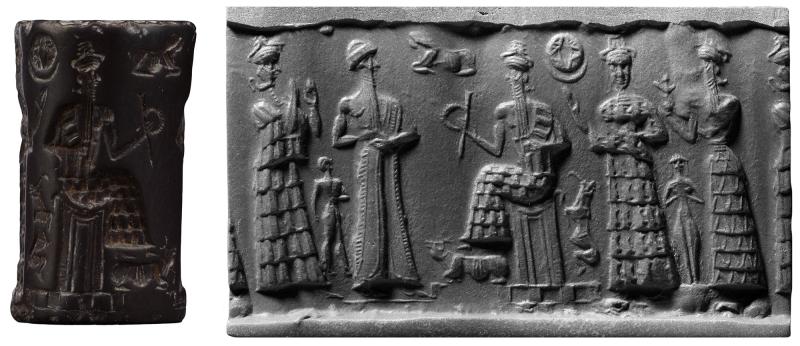
Cylinder chipped.
"In 387 and 388, the god stepping on the dragon rests his hand on a scimitar. In 389 and 390 he is enthroned with his feet on the back of the dragon and appears to hold a rod. Such a rod, together with a ring, appears in the hands of a number of apparently different gods on Babylonian seals. For example, the two objects are held by the enthroned god in 391. This deity may be the sun god, since the latter appears without his saw but with a rod and ring in the relief on the stele bearing Hammurabi's code. This suggestion is possibly confirmed by the appearance in 391 of a bull in the sky and of another under the feet of the deity, since this animal is frequently depicted in association with the sun god on Old Babylonian seals... The double pleats in the robes of the deities resemble corresponding details in impressions on tablets of the time of Hammurabi and of Samsu-iluna, his successor (Louvre A. 527 J, E; Louvre A. 553 A, E). A similar dating is therefore suggested for 391." Porada, CANES, p. 48-49
"Suppliant goddess and worshiper before god with rod and ring on temple throne, his feet on kneeling bull -- Goddess (full face) -- God holding vase with three leaves protruding -- In field, nude male figure; bull (in sky); star disk in crescent above goat sitting on platform behind throne; nude female." Porada, CANES, p. 48-49
God with lightning fork, bull, and mace-bearing figure in ascending posture

"Seals 1020 and 1021 still recall Old Babylonian designs in the general arrangement of their principal figures and in the ascending posture of the gods with emblems. However, the Mitannian elements in these seals are more pronounced; they are manifested by the small designs in the field, and in 1021 by the secondary motif and by the standard held by the god."--Porada, CANES, p. 141
"God with lightning fork placing foot on bull and facing mace-bearing figure in ascending posture -- Small nude female beside vessel above antelope head -- Figure with scimitar facing enthroned figure, between them sun disk, lion, and ball staff -- Stand(?) composed of five globes behind head of enthroned figure -- Six scattered globes in field."--Porada, CANES, p. 141
God with mace and sun god with rays ascending between two mountains
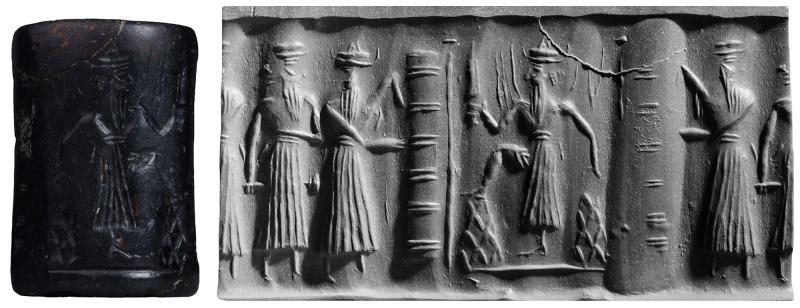
Cylinder rubbed.
"Among the mythological figures on Akkad seals, the most frequent is the sun god, Shamash. One of the distinctive settings in which this god appears is found in 178-186. The god, identified by his saw and usually by rays emanating from his shoulders, is shown in ascending posture either between two mountains, placing his foot on one and resting his hand on the other, or beside a single mountain on which he steps while resting his hand on a mace. Before him attendants throw open the gates of heaven. The fullest elaboration of this motif is found in 178, 179, 181-183... The motif of a sun god with his attendants is sometimes enlarged by the addition of other deities. Examples are: 178, in which a god, at the left of the scene, seems to be hiding a mace behind his back." Porada, CANES, p. 24
God carrying mace -- Sun god with rays, ascending between two mountains -- At either side, attendant opening wing of gate.
God with spiked helmet standing on two mountains and nude goddess opening her veil
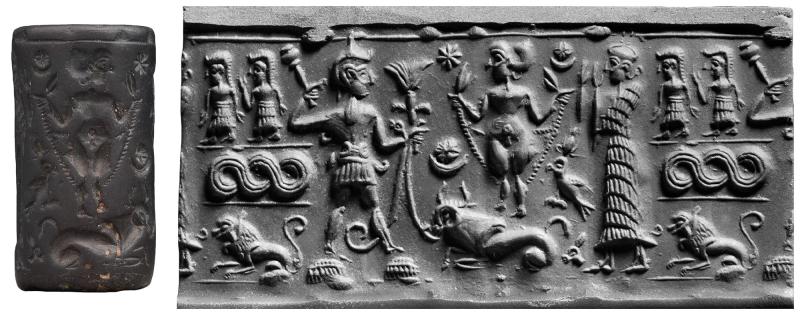
"Indubitable renderings of the weather god are found in 967 and 968. In both these seals he is standing on mountains and brandishing a mace in one hand. In 967 he is shown holding a snake and a bull's rein in the other hand, like the god in 964, though here the snake is clearly depicted, while the third object in the same hand is a lotus blossom, not an ax. This blossom invites comparison with a relief from Ras Shamra in which the weather god holds a spear topped with a plant element, probably a transformed lightning symbol. ... In 967 he faces a nude goddess standing on a bull, like the female deity in 942 and 943. This representation, and a similar one in Brett 90, where, however, the nude goddess appears in a winged inclosure, suggest a connection between these two figures like that predicated in regard to the nude female and the weather god in Old Babylonian seals. ... 966 and 97 show the fastidious engraving that marks the height of Syrian glyptic."--Porada, CANES, p. 129
God with spiked helmet standing on two mountains, brandishing mace, and holding before him snake, lotus blossom and rein of kneeling bull on which nude goddess stands opening her veil -- Suppliant goddess -- Over shoulders of nude goddess, star, cross disk in crescent -- Above bull's head, second cross disk in crescent -- Above bull's tail, bird with Egyptian atef crown -- Below tail, animal head -- Terminal: two female figures, guilloche, sitting lion, one above other.
God with sword and quiver striding over bull-headed dragon and aiming at lion-griffin
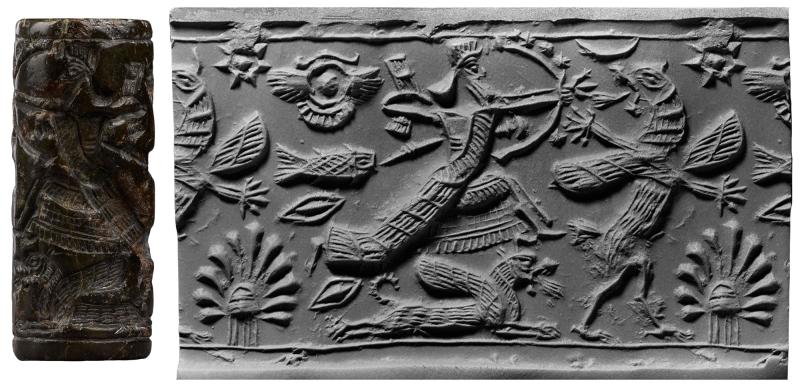
"In 689 the god's victim is not a serpent but the lion-griffin, which appears as the antagonist of heroes from the time of the Third Dynasty of Ur onward. In the discussion of the Old Babylonian contest frieze... it has been suggested that the lion-griffin is to be regarded as a creature of Nergal, god of the nether world. In relation to Neo-Assyrian representations, Schott similarly suggests that the lion-griffin represents a constellation associated with Nergal or equivalently used for this deity, while the god pursuing the lion-griffin is to be regarded as some still unidentified astral deity. However, it must be mentioned that on a relief of Ashurnasirpal II, the god pursuing the lion-griffin holds the lightning fork of the weather god. It is possible therefore that the deity depicted in 689 is the weather god."--Porada, CANES, p. 83
God with sword and quiver striding over outstretched bull-headed dragon and aiming with star-studded bow at lion-griffin that menaces tree -- In sky: winged sun disk, crescent, star -- Fish, two rhombs (behind god).
Goddess with clasped hands, sun god, and worshiper with kid

"There may be some significant relation between the sun god and the goddess standing with clasped hands at the left in 399... The double pleats in the robes of the deities on this seal and on 401 are similar to those seen in 391 above, for which a dating in the time of Hammurabi and Samsu-iluna has been suggested." Porada, CANES, p. 49-50
Goddess with clasped hands, suppliant goddess, and worshiper carrying kid before sun god -- Goddess (full face) -- In field: star; demonic mask above priest with pail and sprinkler; bull, human head, inscription, one above other (before sun god); star disk in crescent above sitting goat.
Goddess with ring and scimitar on star-studded throne
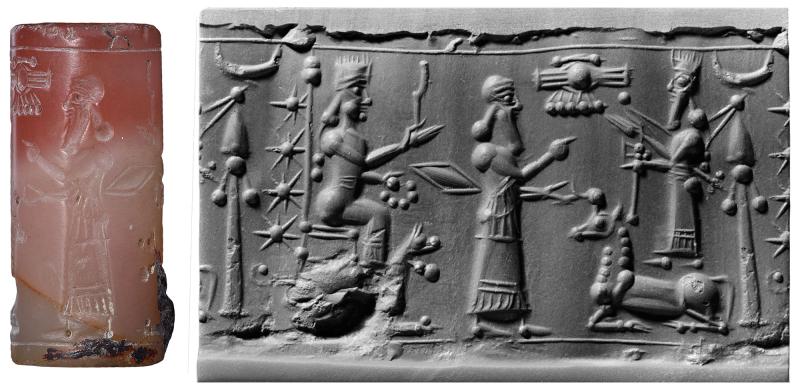
"Seals 692-695, all of which portray worship of deities, resemble in their general rendering the dated sals of this style, most of which belong to the end of the ninth or the beginning of the eight century--for example, B N 354, the seal of Ashur-bel-usur (about 804 B.C.), or Berlin 596, the seal of an officer of Mannu-kima-Ashur (about 793 B.C.)."--Porada, CANES, p. 84
Goddess with ring and scimitar, seated on star-studded throne placed on lion(?); before goddess, rhomb -- Worshiper facing god armed with bows and sword who stands on bull and holds ax; behind god, tasseled spade -- Winged sun disk and crescent in sky.
Griffin in grasp of griffin-demon
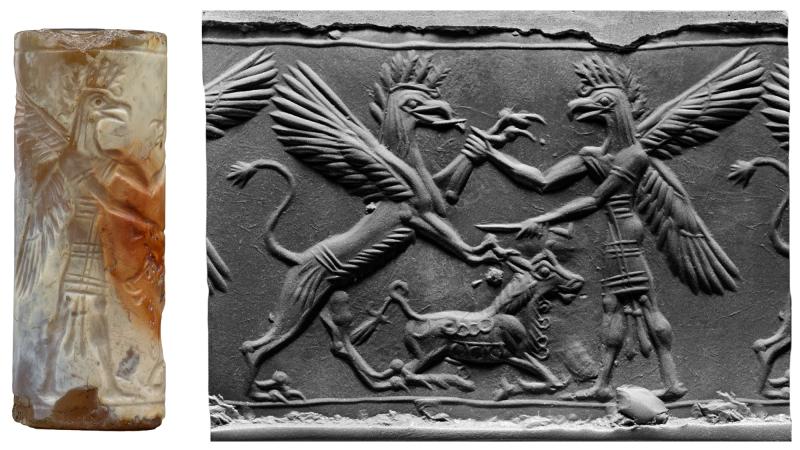
"In 607 and 608, both of which picture a bull calf lying between two contestants, the composition is more formal. The scheme used here--that of two fighting figures with a third between them--was preserved in Neo-Babylonian seals of the first millennium... but discarded by Neo-Assyrian seal cutters. As to the significance of the unusual scene of 608, it may be mentioned that Assyrian texts refer to a divine bull as the son of Shamash, the sun god. Furthermore, Frankfort has interpreted the griffin as the equivalent of the angel of death and the griffin-demon as its antithesis--the latter having potency to ward off the griffin, since it is equipped with the most characteristic features of its monstruous and evil opponent. The scene in 608 may therefore symbolize a struggle between the forces of life and death, in which the imperiled bull stands for a manifestation of the sun. ". Porada, CANES, p. 70
Griffin poised in menace over kneeling calf and held by foreleg in grasp of griffin-demon armed with dagger.
Griffin-demon tearing branch from tree
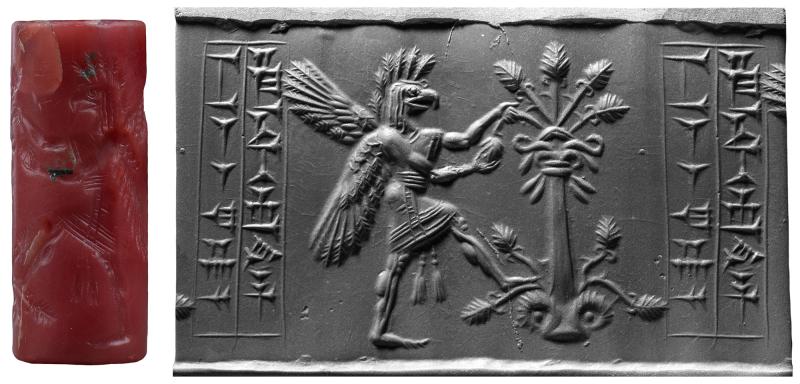
"Seal 609 presents an even more unusual theme in the griffin-demon breaking a branch from a tree. In Neo-Assyrian glyptic and monumental art, griffin-demons are often portrayed in the action of fertilizing the female blossoms of the date palm with spathes that are generally regarded as containing the pollen of this plant. It seems possible that the griffin-demon here is picking off a branch for the purpose of securing such male flowers... The name Ashur-iddin in the inscription of this seal has been regarded by Herzfeld... as referring to the Assyrian year official of 882 B.C. Herzfeld has accordingly dated 609 as belonging to the ninth century B.C. However, since Ashur-iddin is a frequently appearing Assyrian name, stylistic reasons for classifying the seal as belongin to the end of the Middle Assyrian period have outweighed the argument for dating it on the basis of its inscription."--Porada, CANES, p. 70-71
Griffin-demon tearing branch from tree -- Terminal: inscription.
Hero grasping large kicking bird with either hand and stepping on third
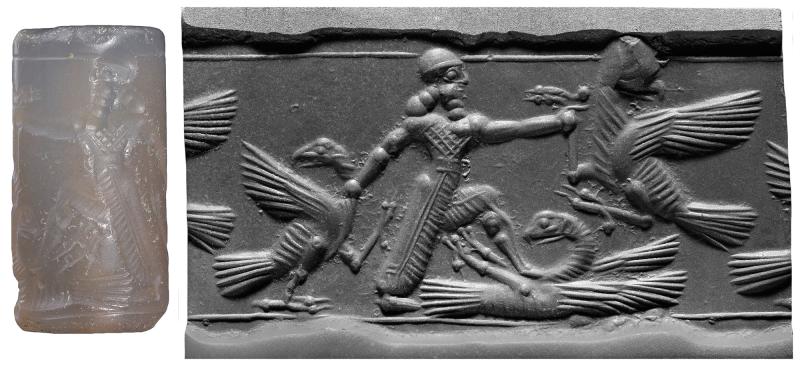
"The earlier group (747-752), comprising cylinders for which a Neo-Babylonian classification is suggested, seems to reflect influence of the Middle Assyrian modeled style, while the later group (753-769) illustrates the specific character of the Neo-Assyrian modeled style of the late eighth and of the seventh century B.C., though in some cases a seal included in this grouping may have been made in Babylonia."--Porada, CANES, p. 90
Hero grasping large kicking bird with either hand and stepping on third.
Hero grasping two lions on backs of kneeling bulls

Cylinder chipped.
"A fourteenth-century dating is indicated for 592 by the fact that the design retains many Mitannian features. There is still a considerable use of the drill, the composition takes in the entire height of the seal, and certain figures--the kneeling bulls, the sphinx, and the griffin--are taken over almost unchanged from Mitannian seal designs." Porada, CANES, p. 68
Center: hero grasping lion at either side, each lion on back of kneeling bull; above each lion, bird of prey; below first lion, kneeling antelope; over whole group, winged sun disk -- Terminal: bird of prey between female sphinx and griffin, each monster resting hind foot on one lion of main motif, other hind foot on small antelope, while forefeet of both monsters rest on crown of palmette tree.
Hero grasping two male sphinxes

"The earlier group (747-752), comprising cylinders for which a Neo-Babylonian classification is suggested, seems to reflect influence of the Middle Assyrian modeled style, while the later group (753-769) illustrates the specific character of the Neo-Assyrian modeled style of the late eighth and of the seventh century B.C., though in some cases a seal included in this grouping may have been made in Babylonia."--Porada, CANES, p. 90
Hero grasping two male sphinxes -- In field: cross topped by globe; rhomb -- Terminal: plant.
Hero with bow and quiver grasping ostrich
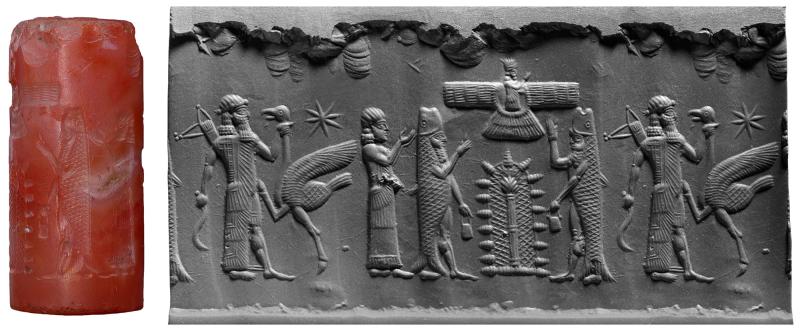
"The central element of the ritual scenes of 770-775 is the sacred tree. In these designs it is rendered in three different ways, namely: with graceful streamers and volutes (770); within the net of lines that may connote irrigation canals surrounded by shoots (772, 773); and realistically as a palm tree (774, 775). In 770 two genii, each with palm spathe and pollen basket, flank the tree... In 770-773 the gesture of the genii and the fish-men implies that the main theme of these seals (especially 770, 773) is the act of pollination of the sacred tree... The figure of a god in a inged sun disk above a tree (773) has been interpreted by Frankfort as standing for Ashur hovering over his symbol, the sacred tree... Seals 770-777 may with certainty be classified as Neo-Assyrian cylinders of the latter part of the eight and of the seventh century. For example, in 770 the genii correspond in posture and garb to genii in the murals of Sargon II... ". Porada, CANES, p. 93-94
Cylinder damaged.
Hero with bow and quiver, holding scimitar and grasping ostrich as it kicks at him -- Female(?) worshiper with cupped hands behind fish-man with pollen basket beside tree -- Above tree, god in winged sun disk -- At other side of tree, second fish-man with pollen basket -- Star in sky.
Hero with curved sword attacking fallen mouflon
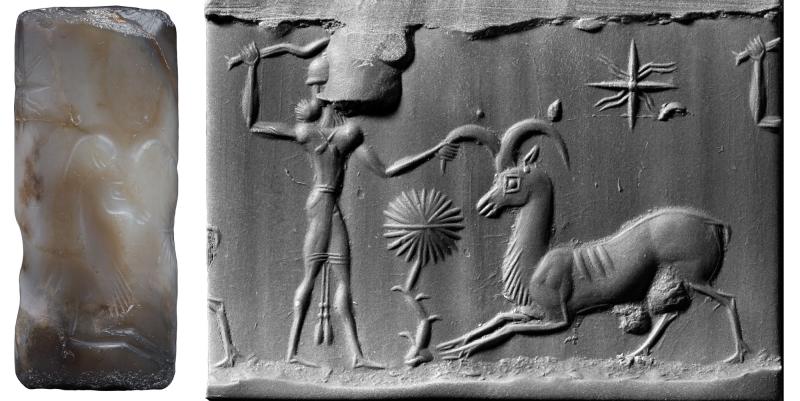
"A somewhat exceptional feature is found in 598, in which a worshiper kneels below a winged sun disk on a stand. Such sun disks on stands occur frequently in Mitannian glyptic (see 1047...), and it may be assumed that the motif is derived from some such Mitannian example. The fact that the kneeling posture was prescribed in connection with some Kassite prayers may account for the position of the worshiper. However, it is noteworthy that here he seems to be floating in the air in an attitude recalling some renderings of the figure holding a rope that hangs from a winged gate on such seals of the Akkad period as 225." Porada, CANES, p. 69
Cylinder damaged.
Hero with curved sword attacking fallen mouflon -- Between them, thistle-like plant, star with rays above.
Ibexes and hero
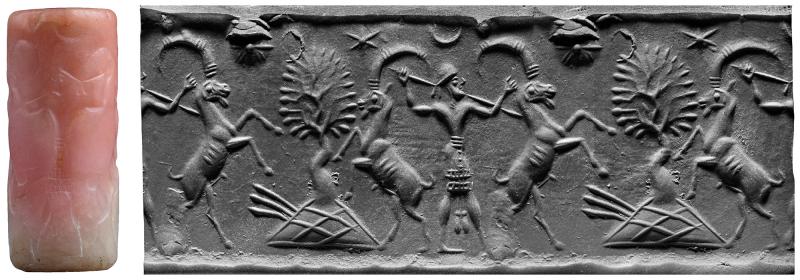
Ibex, hero grasping second ibex and spearing it, both ibexes jumping toward tree on mountain, which they flank at either side as scene repeats -- Star, crescent, and sun in sky.
King standing on two crouching sphinxes and holding in each hand lion suspended by hind leg

"Seals 819-825 show the motif most frequently encountered in Achaemenian cylinders--that of a king holding at bay or subduing two monsters or lions, rendered in a symmetrical composition recalling the Assyrian cylinders 753-763. The king wears the billowy Persian garments in all of these scenes, except for the occurrence of the fringed Assyrian mantle in 822 ... Seals 824 and 825 show the king standing on two sphinxes, as in seal impressions found in the treasury of Persepolis, dating from the time of Darius and Xerxes."--Porada, CANES, p. 103
King standing on two crouching sphinxes and holding in each hand lion suspended by hind leg -- Terminal: palm tree, winged sun disk above it.
Leather craftsmen working in two rooms divided by entwined snake-necked monsters

"The scene on the right has been interpreted by Frankfort (Cylinder seals, 1939, p. 20) as showing leather workers. This seems a good explanation, since the scene includes a figure wielding a mallet, an attendant bearing a skin, and a second skin and a shoe lying on the ground. The precise meaning of the snake-necked monsters framing the scenes of 1 is not known. In contemporaneous seal designs they appear in what seem to be merely ornamental motifs. However, it is reasonable to believe that these strange creatures originally had some mythological significance. It is possible therefore that their presence in 1 raises the import of the scenes from a secular to a religious level. The detached animal heads placed in the upper field of 1 do not have any obvious relation to the action of the scenes. The use of these heads is typical of Uruk designs, in which not only detached animal heads but also legs sometimes occur in the field.".... Porada, CANES, p. 2
Face of first figure at left abraded; slight damage at top end.
Two columns of entwined snake-necked monsters separating design into two scenes-- Left: Standing nude male figure, facing right, cutting up(?) animal or animal skin held over split post, and facing him, a standing nude male figure holding a mallet(?); a fish between them and a horned animal head above -- Right: Kneeling or seated nude male figure, facing left, holding stick and mallet(? ), and, facing him, a standing nude male figure holding animal or skin; a second animal or skin and shoe on ground, and two horned animal heads above.
Lion attacking bull
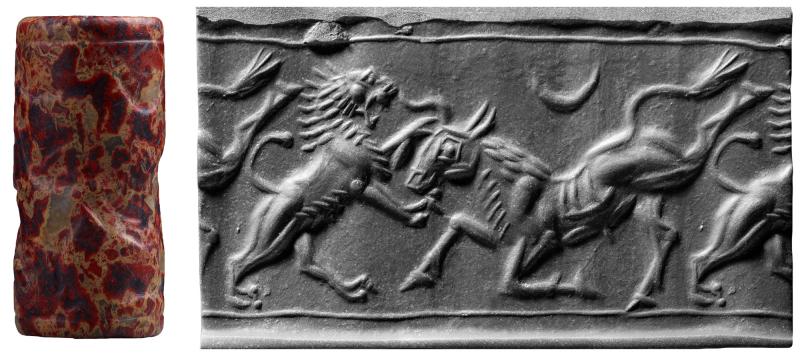
Lion attacking bull that is plunging to its forefeet.
Lion attacking fallen mouflon
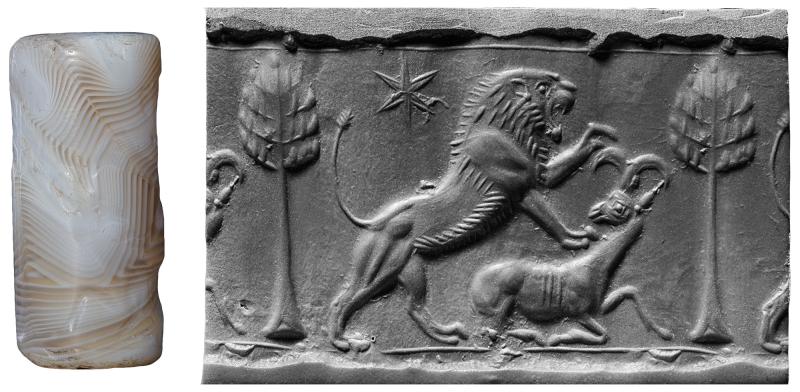
Lion attacking fallen mouflon -- Star in sky -- Terminal: tree.
Lion attacking stag ascending mountain

Lion attacking stag that is ascending mountain on which are tree and two plants -- Bird of prey in sky.
Lion-griffin attacking bull
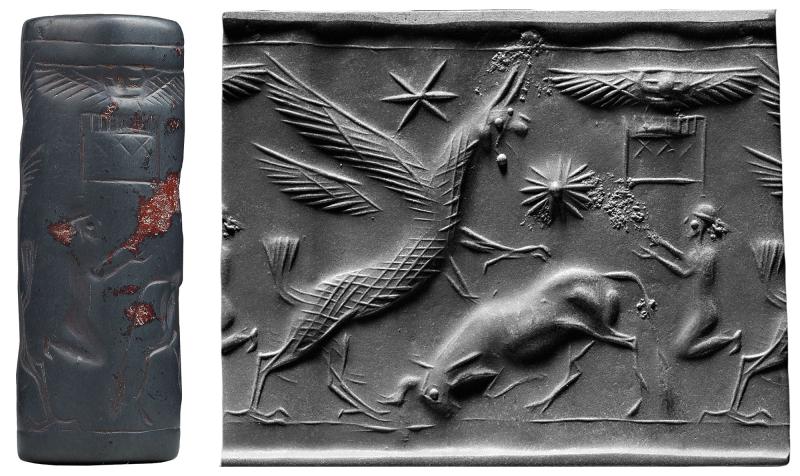
"A somewhat exceptional feature is found in 598, in which a worshiper kneels below a winged sun disk on a stand. Such sun disks on stands occur frequently in Mitannian glyptic (see 1047...), and it may be assumed that the motif is derived from some such Mitannian example. The fact that the kneeling posture was prescribed in connection with some Kassite prayers may account for the position of the worshiper. However, it is noteworthy that here he seems to be floating in the air in an attitude recalling some renderings of the figure holding a rope that hangs from a winged gate on such seals of the Akkad period as 225." Porada, CANES, p. 69
Lion-griffin attacking bull fallen on its forelegs -- Star and sun(?) in sky -- Behind bull, winged sun disk on stand or altar, kneeling worshiper below.
Lion-griffin in grasp of bearded hero with ax

"Palm trees marked with volutes are found in 596 and 597. This use of volutes recalls Mitannian designs, though in the latter the tree as a whole always conveys an impression of artificiality, whereas on the Middle Assyrian seals it has the appearance of a natural tree merely ornamented with metal bands." Porada, CANES, p. 69
Lower part of cylinder broken off.
Lion-griffin in grasp of bearded hero brandishing ax -- Terminal: tree with volute below branches; monkey perched at top, eating fruit; ibex at left, bird of prey at right.
Lion-griffins attacking bull

"Dating of 594 in the fourteenth century is indicated by its similarity to a seal impression of that time (Weber 316a). In each instance a decorative motif is formed by using the wings of the lion-griffins to frame a palmette tree. In the scene of the impression the shoulder feathers of the lion-griffin's wings are indicated by drillings. This distinctive detail (which appears to derive from Mitannian designs), though it is lacking in 594, does appear in 595." Porada, CANES, p. 68
Two lion-griffins attacking bull between them -- Terminal: palmette tree.
Lion-headed eagle clutching hindquarters of two ibexes
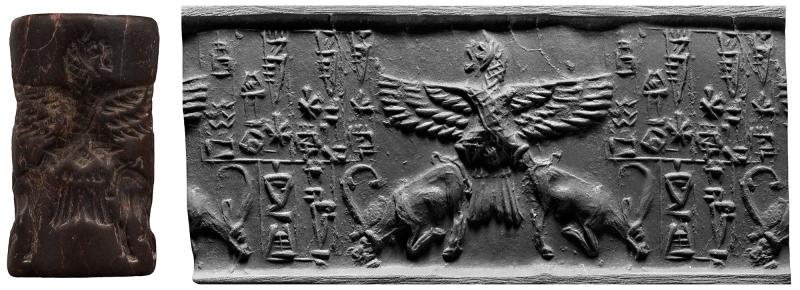
"Seals 264-266, each of which presents a frieze with an eagle in the center, are characterized as Post-Akkad stones by their deeply incised engraving. Moreover, the eagle in 264 and 265 corresponds with a similar figure in Berlin 247, a seal showing in its lower register the birds found to be distinctive of Post-Akkad cylinders (258, 260). Of this group, 267 is the only seal that shows a continuation of Akkad style. It is included here because of its Sumerian inscription, which is typically Post-Akkad. The subject of the seal, a lion-headed eagle clutching animals, is an Early Dynastic theme found especially on the monuments of Lagash, where it still persisted in Post-Akkad times. For example, the theme is treated in a manner similar to that of this seal, but with lions replacing the ibexes, on a stele of Gudea, a ruler of Lagash in the latter part of the Post-Akkad period. It seems possible, therefore, that 267 was made at Lagash in or about the time of Gudea." Porada, CANES, p. 32
Lion-headed eagle clutching hindquarters of two ibexes -- Terminal: inscription.
Male figure before goddess drawing aside her mantle
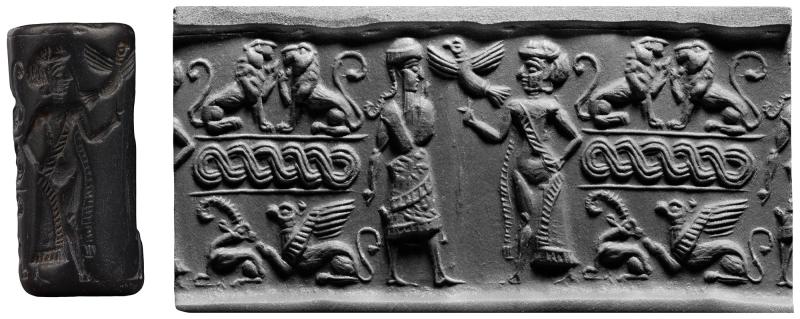
"In 945 and 946, the nude female is partly clothed, but the mantle falling over one leg, far from covering her nudity, serves only to accentuate it. This is especially true in 945, where she is shown holding the mantle to one side. The male personage facing her in 946 is clad much like the worshiper in 910. in what has been judged to be royal attire (in 945 only his cap is like that in 910). The fact that the nude female usually appears with a mantle in scenes in which she is associated with such a personage, for example in Louvre A.934, may indicate that this rendering illustrates her specific aspect in relation to that figure, presumably a king."--Porada, CANES, p. 124-125
Male figure before goddess drawing aside her mantle, bird perched on her finger -- Secondary motif: two sitting lions, facing, above guilloche -- Below it, ibex pawed by griffin.
Man astride eagle over sheep dogs, shepherds, and ram and sheep

"Seal 236 probably illustrates the myth of Etana, the shepherd king who flew to heaven on the back of an eagle to obtain the plant of birth for his childless wife." Porada, CANES, p. 29
Man astride eagle in sky over two sitting sheep dogs, shepherd standing behind each dog; shepherd at left holding whip and pail, shepherd at right resting on stick and followed by ram and three sheep -- Above this group, crisscrossed rectangle and two men, each on one knee, with large vessel between them -- In sky, crescent, small vessel, and large vase (beside eagle).
Man prodding plowing ox
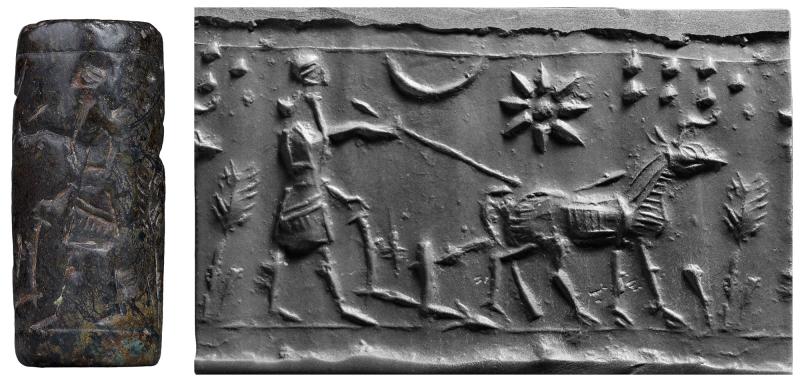
"In 653 the usual worshiper is omitted. The scene portraying a man plowing may nevertheless have a ritual significance; perhaps, like 647..., it depicts a rural ritual, in this case connected with agriculture. The deep cutting conforms with that of such ninth- or eighth-century stones as Berlin 682, and the seal may be of similar date."--Porada, CANES, p. 78
Man prodding ox with which he is plowing; before ox, plant -- In sky, crescent, star, seven globes.
Nude goddesses with opened veil, worshiper holding hare
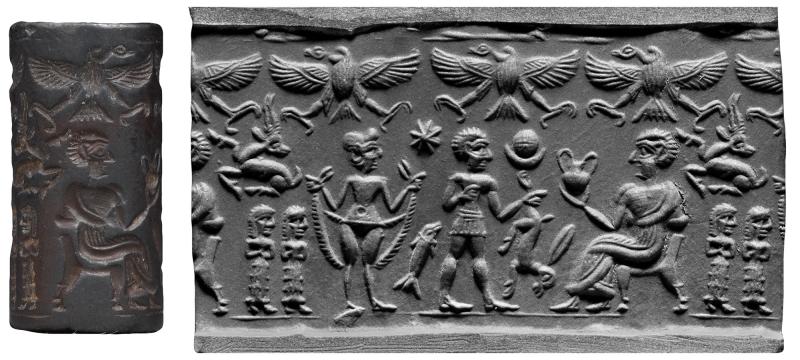
"The figure of a woman lifting the ends of her veil and displaying her nudity, as found in 937-944, is differentiated from the earlier Syrian and Cappadocian representations of a nude female by a more rounded form and a more elaborate coiffure. The hair is bound up in the back, but otherwise it resembles the ornate coiffure of the goddess in an ivory relief from Ras Shamra that reflects the feminine fashion prevailing in the Levant and in the Aegean regions around the middle of the second millennium. A dating at about this time is likewise suggested by the vase held by the enthroned figure in 937, since it corresponds in shape with a Mycenean gold cup dated in the second half of the sixteenth centuy B.C. ... Sometimes she stands before an enthroned male figure who my, by the mere fact that he is seated, be characterized as a superior deity (937, 938)."--Porada, CANES, p. 124
Nude goddess with opened veil -- Worshiper holding hare behind leg before enthroned deity(?) with cup -- In sky, star, sun disk in crescent -- Fish in field -- Terminal: sitting antelope above two small female figures -- Upper border, three vultures with spread wings.
Nude one-eyed hero holding two lions; inclosure containing sheep; sheep-headed demon

Cylinder unperforated; in both top and bottom shallow central cavity and outer circle of small depressions.
"Seal 4 presents as its central figure a cyclopic hero holding lions. The rest of the scene includes animals, pots, and other types of containers, as well as a human figure and two lion-headed eagles, all apparently meant to be within an inclosure indicated by two stockade-like frames. A related theme is found in a fragment of a vase from Khafajah.... The nude bearded hero seen in 4 remained a stock figure of the Mesopotamian repertory, aapearing for the most part in contst scenes. The cyclopic version of this figure in 4 is paralleled in only one other instance, an Early Dynastic seal impression from Fara (ancient Shuruppak). A plaque from Khafajah of some thousand years later shows a cyclopic demon whose head has the form of a sun. Because of the wide gap in time, however, there is no assurance that the hero in 4 is to be associated in any manner with this figure."--Porada, CANES, p. 3
Center: nude one-eyed hero holding two reversed lions, two more lions forming pyramid above him -- Left: section of inclosure containing sheep, latter between two pots, with lion-headed eagle perched on head of sheep; basket, pouch(?), fish, and bird in upper field -- Right: sheep-headed demon grasping pole of second section of inclosure; within latter, human figure(?) with upturned curls holding in outstretched hands indefinable curved object marked by vertical incisions; lion-headed eagle above horns of sheep-demon; crib(?) in upper field.
Nude winged goddess holding two gazelles by hind legs
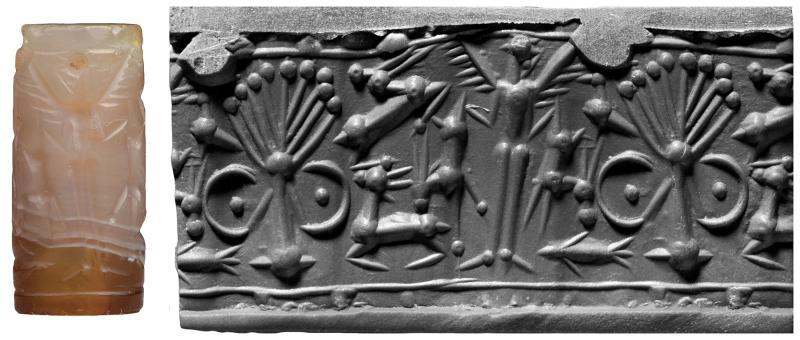
"The figure holding up animals in 1051 seems to be an abbreviated rendering of the demon in 1050. In both cases the rendering of the hips suggests that the figure is female. It is difficult to determine whether the treatment in 1050 and 1051 indicates that the figure between animals is always to be regarded as female, even in those scenes which are so cursorily rendered that it is hard to decide whether the form is that of a demon or of a bird (1052-1058)."--Porada, CANES, p. 146
Nude winged goddess holding two gazelles by their hind legs -- Tree with bird and fish at left, two kneeling antelopes at right.
Plant, three stags approaching

Scorpion and plant
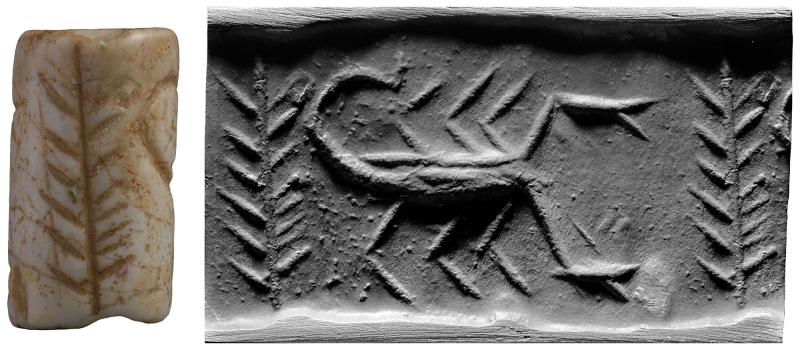
"... a pot of the Jamdat Nasr period shows a scorpion in a panel and the effect is much the same as that produced by the design of seal 31."--Porada, CANES, p. 6-7
Scorpion -- Plant.
Shrine before three goats

"A row of animals in conjunction with a shrine, as found in 22-25, is a typical theme of the Jamdat Nasr period. It is generally assumed that this row denotes a temple herd." Porada, CANES, p. 6
Shrine before three goats placed over undulating lines -- In field: two pots.
Shrine, with one worshiper(?) holding palm leaf(?) and pot, and second worshiper pouring liquid into pot before him

"Seal 3 has been interpreted by E.D. Van Buren as showing priests performing a rite before a shrine. However... it is difficult to judge the character of the figures with certainty, although nudity has often been taken to distinguish priests in representations of later periods." Porada, CANES, p. 3
Shrine -- Worshiper(?) holding palm leaf(?) and pot -- Second worshiper pouring liquid into pot before him.
Three spider-like designs

Three spider-like designs.
Tiered rows of walking boars
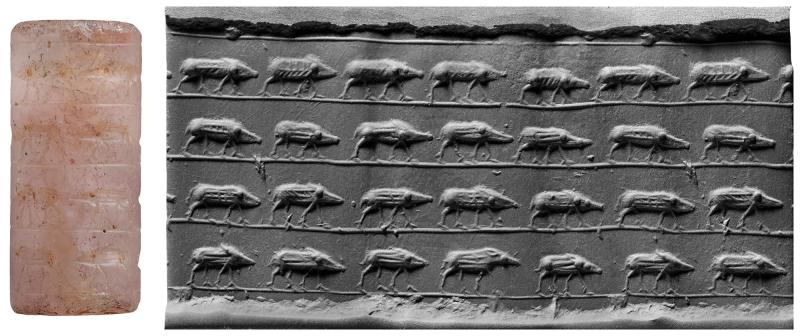
"Seals 835-839 present animals as their principal subjects. Although 835 has no parallel among Achaemenian designs, it is included here becasue the lions, in respect to their erect posture as well as the linerar treatment of their muscles, resemble the animals in contest scenes of the fully developed Achaemenian style. Though the arrangement of animals in tiered rows found in 836 is likewise unparallelled, the boars of this seal often appear in Achaemenian glyptic (831)."--Porada, CANES, p. 104
Four tiered rows of five walking boars each.
Tree on mountain beside three shoots and stag
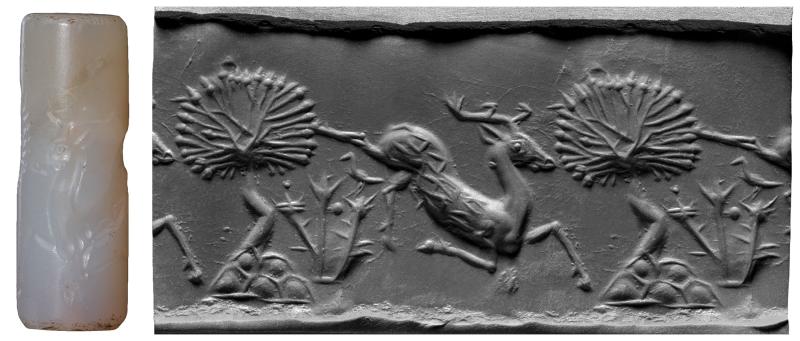
Tree on mountain beside three shoots, with bird on one of them -- Stag leaping down from mountain.
Two facing suppliant goddess with star disk in crescent

"A number of cylinders (958-960) picture a winged goddess holding a spear or some other weapon that indicates her martial character. That the figure represents a goddess and not a god is indicated by the headgear, a square horned miter seen only on female deities ... In 959 the goddess appears to be supervising a contest between two gods, one of whom is identified by the crescent on his helmet as associated with the moon. Seal 960 shows her in a chamber formed by guilloches, while outside of this inclosure suppliant goddess are worshiping scorpions, perhaps her symbol. ... The portrayeal of the suppliant goddesses in 960 does not deviate greatly from Old Babylonian examples; this may support a dating of the seal near the time of the First Dynasty of Babylon." . Porada, CANES, p. 128
Two facing suppliant goddesses, between them, star disk in crescent, three scorpions, one above other -- Winged goddess with spear and scimitar in chamber formed by guilloches.
Two figures attacking bearded hero with curls
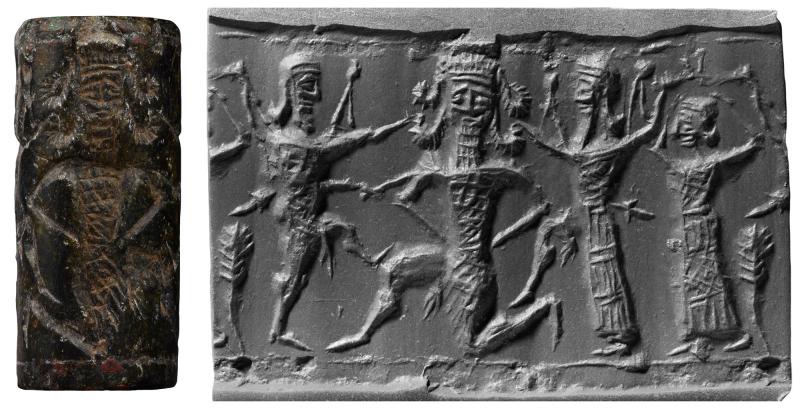
"Only two indubitably mythological motifs are found on Neo-Assyrian cylinders: one is that of an attack upon a nude barded hero (686)... The first theme is probably derived from representations of the slaying of the giant Humbaba by the heroes Gilgamesh and Enkidu, as portrayed on an Old Babylonian plaque, on which Humbaba is rendered as a monster. In the melting pot of Mitannian glyptic, however, the rendering of this monster became confused with that of the nude bearded hero. This modification seems to have been taken over by the Assyrians in such seals as 686, on which the victim is clad in a crosshatched garment, or Berlin 608, on which he appears nude, as in older representations."--Porada, CANES, p. 82
Two figures attacking bearded hero with curls -- Female figure with upraised arms -- Terminal: plant.
Two seated female figures with vessels; cows lying on mountains

"Uruk features on this seal are the bull, rendered with considerable plasticity and without pronounced use of the drill, and the mountains, rendered like those in a seal impression of the Uruk period. However, pigtailed figures, squatting on a bench or a mat and associated with pots, are one of the most usual features of Jamdat Nasr seals. They are rendered in 7, as also in 8-16, by means of a few drill holes, with thin lines for the arms and pigtail. The presence of cows in 7... suggests that the function of the pigtailed figures is the preparation of dairy products, perhaps for ritual purposes." Porada, CANES, p. 4
"Two figures each squatting on bench or mat, alternating with two cows each lying on mountain, pot before each cow." Porada, CANES, p. 5
Two winged lion-demons flanking nude bearded hero with streams flowing over each shoulder

"The bull-man of the Old Babylonian repertory is rarely found in Syrian seals ... Syrian seals more frequently show the nude bearded hero as a water bearer with flowing vase (979), a representation for which Old Babylonian renderings like 517 ... probably served as examples. Both in 979 and in the Syrian seal Berlin 545, two stars appear above the hero's shoulders, suggesting that he has some astral significance."--Porada, CANES, p. 133
"The representation of a nude bearded hero with two stars over his shoulder ... might be interpreted as the equivalent of the constellation we know as Aquarius"--In August Company, p. 60
Two winged lion-demons, one at either side of nude bearded hero with stream flowing over each shoulder, star at either side of his head -- In field: hand; human head -- Terminal: bird and hand before ibex above walking lion with animal head above its back.
Vegetation god with stalks of grain, god with plow, and god enthroned on heap of grain
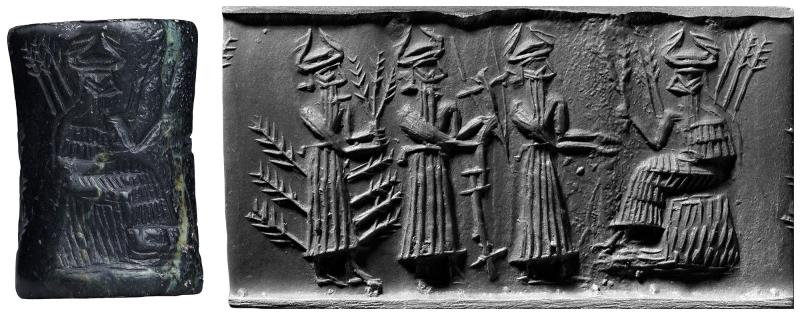
"Male and female deities associated with the cultivation of grain are represented in 207-214. The fullest characterization of them is found in 207 and 212. In these latter seals the principal deities are seated on heaps of grain; stalks of grain sprout from their shoulders and rest in their hands. In 207 a plow is carried before the deity ... The gesture of the minor god standing with hands outstretched before the enthroned deity of grain in 207 and 210 is typical of scenes featuring this divinity." Porada, CANES, p. 26
God with stalks of grain growing from his skirt and three other stalks in his hand, following god with plow and third god toward deity enthroned on heap of grain, who holds three stalks, while other stalks sprout from his shoulders.
Water god with flowing vase, god attacked by lion-headed eagles, and god brandishing mace

"Another deity often shown on Akkad seals is the water god, Ea, who bears a vase from which two streams flow over his shoulders; usually there are fishes swimming along these streams. Seals 195-197 embody a frequent theme involving this god--that of a bird-man led captive toward the god ... Seals 199-201 have been interpreted by Frankfort as depicting the victory over Zu, the bird-man, with the water god receiving the joyous news." Porada, CANES, p. 25
Water god, holding flowing vase with fishes along its streams, standing with foot on mountain and facing minor god -- God fallen on one knee under attack of one large and one small lion-headed eagle, larger held by god brandishing mace -- Terminal: Empty panel over small man.
Water god, two-faced god, and two minor gods carrying plant and bird-man
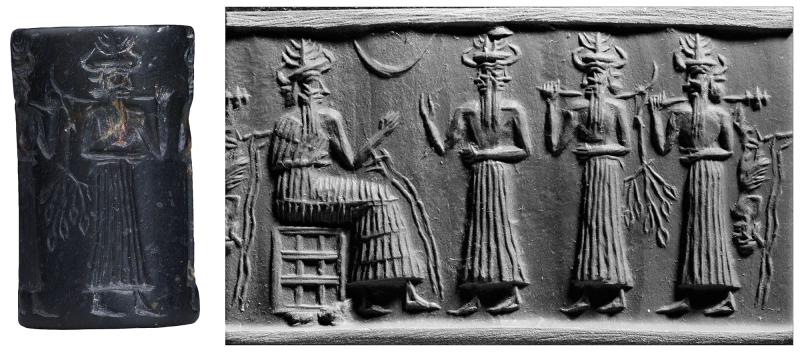
"Another deity often shown on Akkad seals is the water god, Ea, who bears a vase from which two streams flow over his shoulders; usually there are fishes swimming along these streams. Seals 195-197 embody a frequent theme involving this god--that of a bird-man led captive toward the god. Seal 198 shows the captive brought hanging from a mace, while a plant--presumably stolen by him--is carried pendant from a stick in a procession led by the water god's two-faced minister." Porada, CANES, p. 25
Enthroned water god holding flowing vase, crescent in sky before him -- Approaching, two-faced god preceding two minor gods, the first carrying plant hung from curved stick, the second carrying bird-man hanging from mace.
Winged hero brandishing sword and grasping ostrich
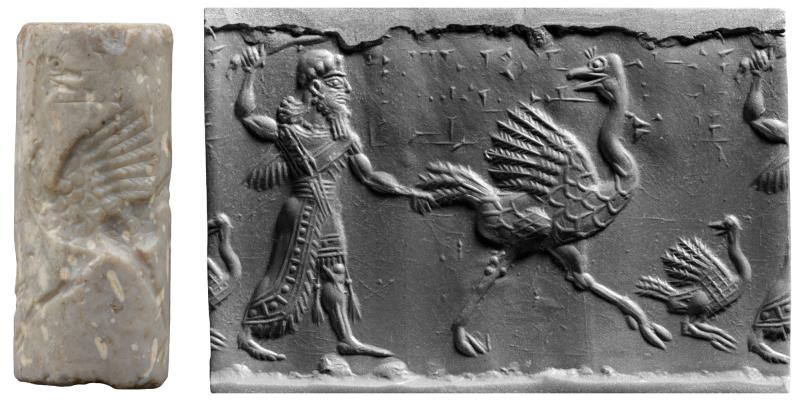
"The interpretation of the griffin as an equivalent of the angel of death may furnish an explanation for the scene of 606, which shows a winged hero pursuing ostriches, usually regarded as harmless animals. Nevertheless the Assyrian may have seen an earthly counterpart to the supernatural griffin in this bird, because of its size and because it lives in the desert, which was believed to be an abode of the dead."--Porada, CANES, p. 70
Winged hero brandishing sword and grasping ostrich in flight; beside latter, smaller ostrich -- In field, inscription (erased).
Winged hero with scimitar, bull, and lion

"The earlier group (747-752), comprising cylinders for which a Neo-Babylonian classification is suggested, seems to reflect influence of the Middle Assyrian modeled style, while the later group (753-769) illustrates the specific character of the Neo-Assyrian modeled style of the late eighth and of the seventh century B.C., though in some cases a seal included in this grouping may have been made in Babylonia."--Porada, CANES, p. 90
Partly preserved copper setting on top and bottom.
Winged hero with scimitar holding reversed bull as he confronts attacking lion.
Winged lion-griffin attacked by hero with curved sword
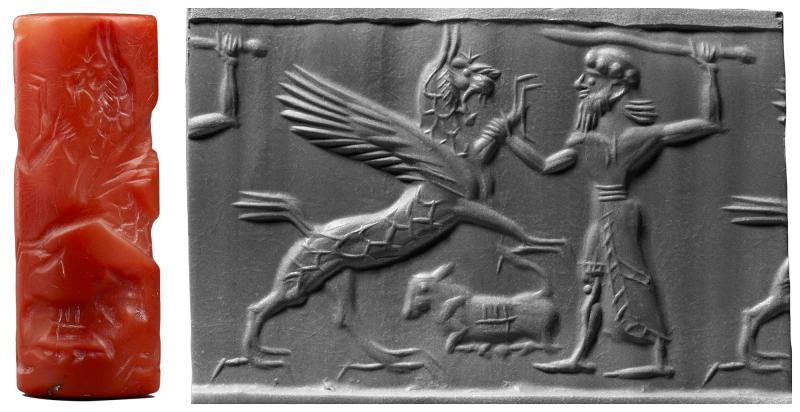
"In 607 and 608, both of which picture a bull calf lying between two contestants, the composition is more formal. The scheme used here--that of two fighting figures with a third between them--was preserved in Neo-Babylonian seals of the first millennium... but discarded by Neo-Assyrian seal cutters."--Porada, CANES, p. 70
Winged lion-griffin attacked by hero with curved sword -- Kneeling calf under monster.
Worshiper and god with vase seated on throne supported by human-headed bulls
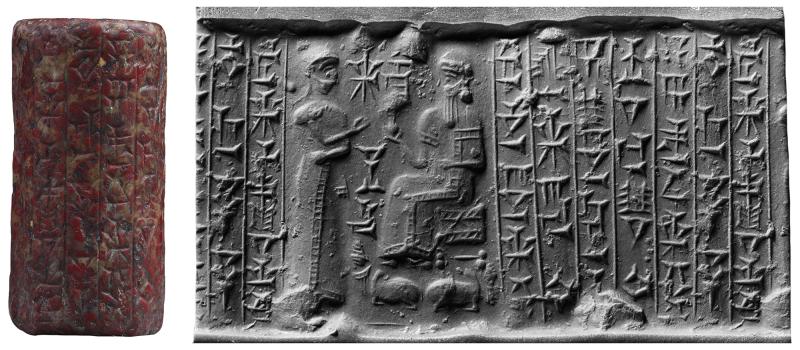
Cylinder damaged.
"Seals 568-585 represent the earlier stage. Most of the designs of this group show elongated figures and extensive inscriptions containing prayers. This style seems to have evolved at about the beginning of the Kassite period. The phase of transition from Old Babylonian designs to Kassite cylinders of this type is clearly marked by pieces like 568 and 569. The style is therefore referred to as Early Kassite, despite the fact that it appears to have survived into the later centuries of Kassite rule. This is indicated by the names of the Kassite kings found in some of the inscriptions..."--Porada, CANES, p. 63
Worshiper facing god who holds vase(?) and is seated on throne supported by two kneeling human-headed bulls -- Terminal: Inscription, one line carried into field.
Worshiper before two altars
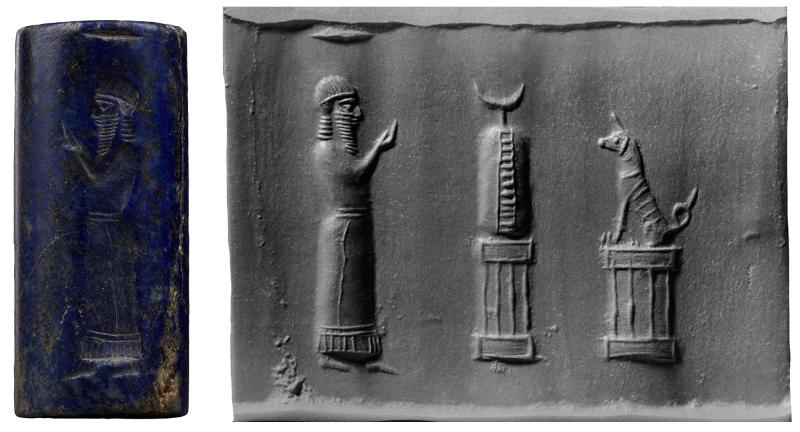
"Most of the seals of this group [781-788] show a worshiper standing before divine symbols. The Babylonian origin of these cylinders is well attested by the appearance of the same theme, similarly rendered, in seal impressions on Neo-Babylonian tablets. The earliest of these date from the time of Nebuchadrezzar II, in the earlier half of the sixth century B.C., the latest from the time of Darius II, at the end of the fifth century. In contrast to the manner in which Assyrian worshipers are postured, the worshiper in this group of seals is depicted as gesturing with one hand only. Moreover, his garment has folds at the back and fringe only at the bottom (781, 784, 785). The symbols approached by the worshiper are often placed on stands shaped like temples. Celestial symbols, such as the linear crescent, are placed on a curious object, perhaps a stone, that rests on such a stand." . Porada, CANES, p. 95
Worshiper before two altars. On first altar, crescent mounted on stone(?), on second, sitting dog.
Worshiper led by minor goddess toward enthroned god
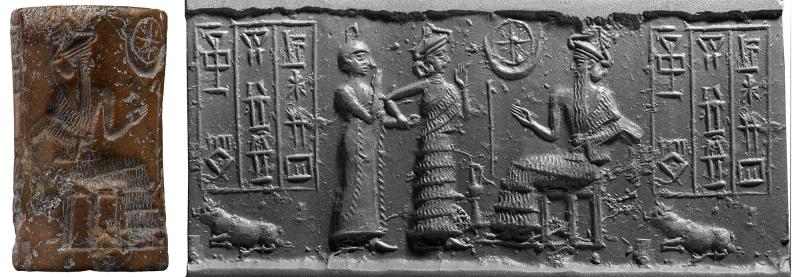
"The type of scene most frequently found on cylinders of the Third Dynasty of Ur shows a minor goddess leading a worshiper by the hand toward an enthroned deity (277-287), who is more often female than male. Usually the throne resembles a shrine. This scheme is derived from such Akkad seals as 190, with the difference that now the enthroned deities are rarely identified by the objects they hold or by other distinctive features of their appearance. A crescent is usually placed in the sky before the enthroned deity; often a bird or some other animal appears near the knees of the figure."--Porada, CANES, p. 35
Worshiper led by minor goddess toward enthroned god; before latter, star disk in crescent, staff, vase -- Terminal: inscription in panel over kneeling bull.
Worshiper offering gazelle to god enthroned on platform and grasping Egyptian life sign
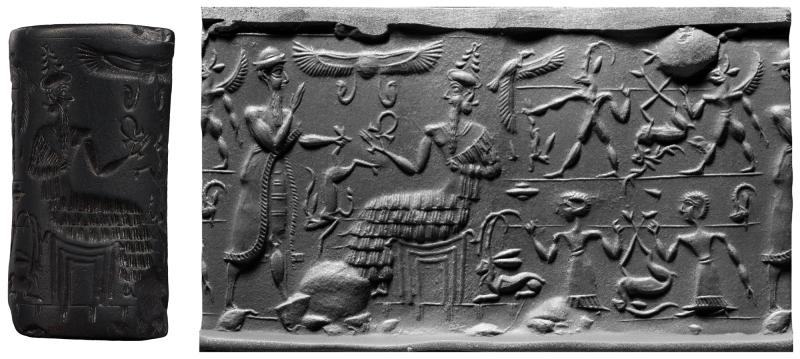
"Seals 910-913 show worshipers before a seated deity; ... The shape of the throne, which in 910-913 resembles that of a temple, is characteristic of scenes of the Third Dynasty of Ur and of early Old Babylonian designs ... Since 910 has been referred to the time of Hammurabi, 911-913, which present related subjects, may be similarly dated, though the deities are rendered not with horned miter as in 910 but with the more typically Syrian short curled hair. The worshiping scenes of 910-913 can be differentiated from their Mesopotamian parallels by the egyptianizing character of the objects held by the enthroned deities ... Of the small symbolic designs that appear in the field in Old Babylonian seals, only the ball staff and vessel recur with any frequency in these Syrian seals."--Porada, CANES, p. 118-119
Worshiper offering gazelle, held by hind leg, to god enthroned on platform and grasping Egyptian life sign -- Between figures, sun disk with pendant uraeus-like snakes -- Behind throne, recumbent ibex with triple-ringed cup above it -- Secondary motif: above, ibex-demon holding hare by hind leg and winged bull-demon, both shouldering bar from which stag is suspended, with vulture perched on front tip of bar -- Below, two attendants carrying bar from which antelope is suspended, with ibex head impaled on rear end of bar.
Worshiper pouring libation before goddess standing on lion-griffin that draws chariot driven by weather god
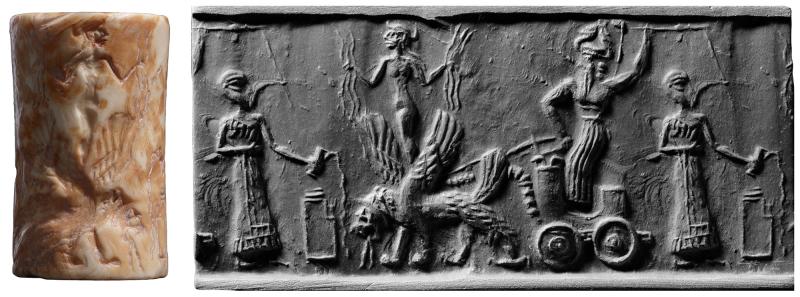
"Two deities who are obviously weather gods appear in 220--a goddess holding bundles of rain, and a god in a chariot, brandishing a whip, who brings to mind thunder and lightning. A parallel exists for the goddess standing on a lion-griffin that draws the god's chariot; however, the more frequent Akkad representations of these deities show both figures standing on such monsters." Porada, CANES, p. 28
Worshiper pouring libation over altar before goddess standing on lion-griffin that draws chariot in which weather god stands cracking whip.
Worshiper, nude bearded hero holding gatepost, two-faced god, and enthroned water god
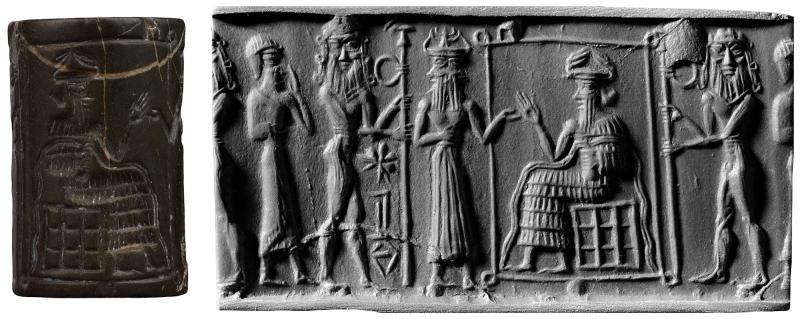
Cylinder damaged.
"Another deity often shown on Akkad seals is the water god, Ea, who bears a vase from which two streams flow over his shoulders; usually there are fishes swimming along these streams ... Seal 202 shows the water god seated in his ocean chamber ... In 202, 203, 205, the god is shown approached by worshipers." Porada, CANES, p. 25
Worshiper -- Nude bearded hero holding gatepost -- Two-faced god reaching into frame within which water god sits enthroned, holding vase with fishes along its streams -- Second nude bearded hero holding gatepost -- In field, inscription.
Zigzag ladder designs forming two triangles
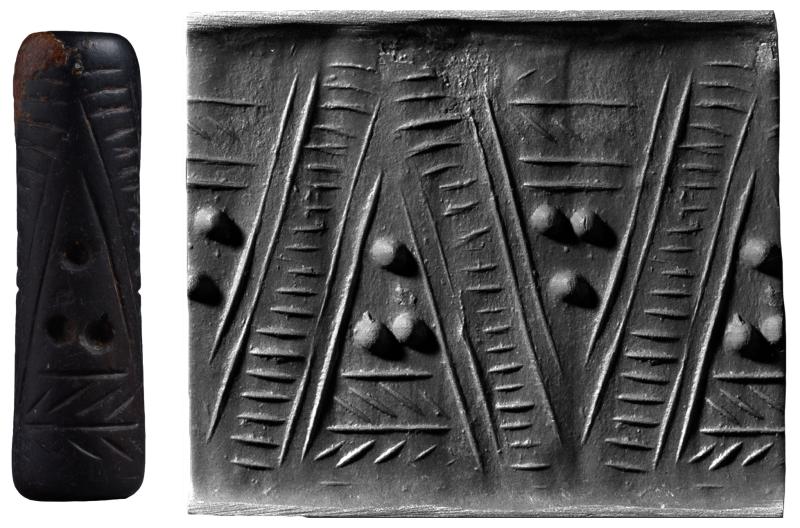
"[35] shows patterns probably derived from weaving and mat plaiting." Porada, CANES, p. 7
Zigzag ladder designs forming two triangles, three drillings in each.
Tablet Inscribed in Akkadian with a Fragment of the Epic of Adapa
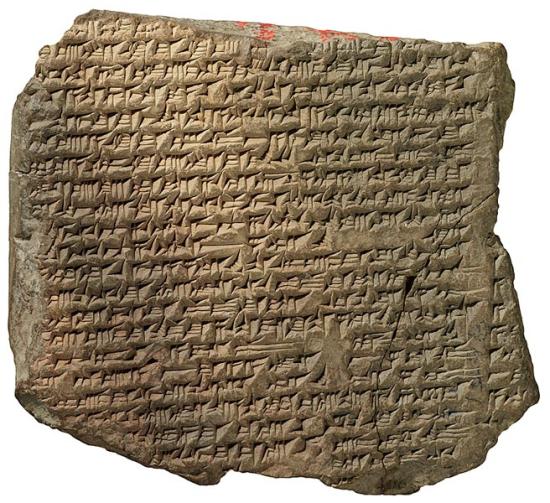
Tablet Inscribed in Akkadian with a Fragment of the Epic of Adapa
Alapa, the first of the antediluvian sages, is equated by some modern scholars with the biblical Adam. In the epic he rovokes the divine wrath and is summonef before the heavenly tribunal, where he is offered the bread of life. He refuses, and mankind loses the opportunity to win immortality as did Adam when, in the Garden of Eden, he failed to eat from the tree of life and instead tasted the forbidden fruit. The story breaks off when Adapa returns to earth still a mere mortal.
He (the god Ea) made broad understanding perfect in him (Adapa), to disclose the design of the land. To him he gave wisdom, but did not give eternal life ... (The god Anu's) heart was appeased, he grew quiet. "Why did Ea disclose to wretched mankind The ways of heaven and earth, Give them a heavy heart? ... What can we do for him? Fetch him the bread of (eternal) life and let him eat." "Come, Adapa, why didn't you eat? Why didn't you drink? Don't you want to be immortal? Alas for downtrodden people!"
Eye Stone Amulet
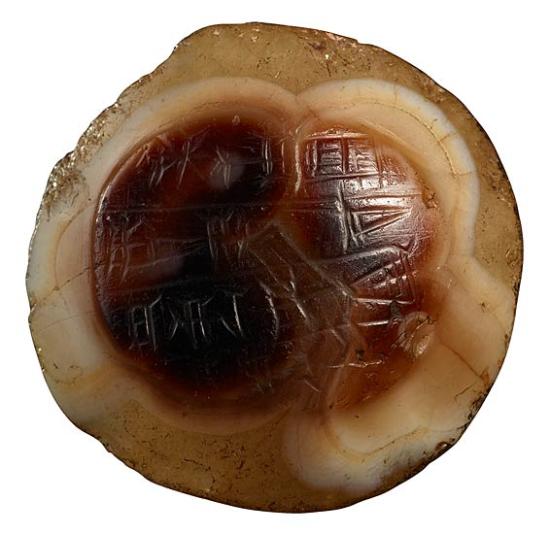
Eye Stone Amulet with a Dedication Inscription of King Kurigalzu I in Sumerian
Inscribed: To Enlil, his lord, Kurigalzu presented (this stone)
Taking advantage of the stone's natural banding, agates were carved to resemble an eye. The votive inscriptions indicate the placement of the object on an altar or in a temple as a gift to a deity. The stones were thought to have some inherent power that would help protect the life of the person named in the inscription. These amulets probably adorned the cult statue of the god inscribed and were most likely worn in precious gold settings.
Kurigalzu, whose name means "shepherd of the Kassites," was an energetic monarch in both international and domestic areas. He maintained close diplomatic and economic ties with Egypt and is said to have received much gold from the Egyptian court. He built a royal residential city and named it after himself. He also built at older cult centers, such as Nippur, where this amulet probably came from, perhaps even from the Enlil Temple restored by Ur-Namma.
The agate was found probably at Babylon, where Marduk was the patron god of the city.
Tablet Inscribed in Akkadian
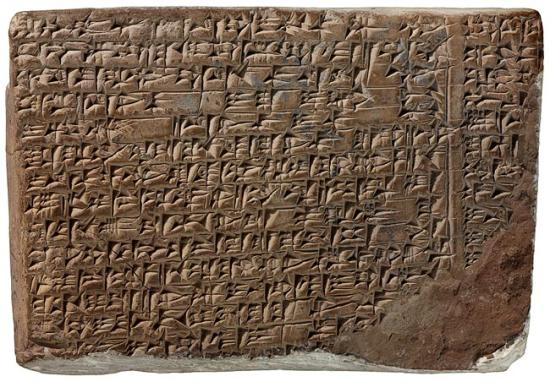
Tablet Inscribed in Akkadian with a Fragment of the Epic of Etana
Etana was according to the legend, the first king after the Flood. In the Epic, Etana is childless; meanwhile an eagle has ignored his own children's advice and eaten the children of his friend, a serpent. All three pray to Shamash (the sun god) for help. Shamash helps the serpent avenge his loss but sends Etana to help the eagle, who helps him in return. The scene in which the eagle carries Etana to heaven in search of a magical fertility plant is famous for being the only episode in Mesopotamian literature identifiable in ancient illustrations (Seal no. 30).
Etana...spoke to the eagle,
"O my friend give me the plant of birth,
Show me the plant of birth!
Remove my shame and provide me with a son!..."
The eagle hunted around (in the mountains)
But (the plant of birth) was not (to be found there).
"Come, my friend, let me carry you up...
(Let us meet) with Ishtar, the mistress (of birth)... "
(The eagle) took him upwards for a mile.
"My friend, look at he country! How does it seem?"
"The affairs of the country buzz (?) (like flies?)
And the wide sea is no bigger than a sheepfold!..."
Eye Stone Amulet
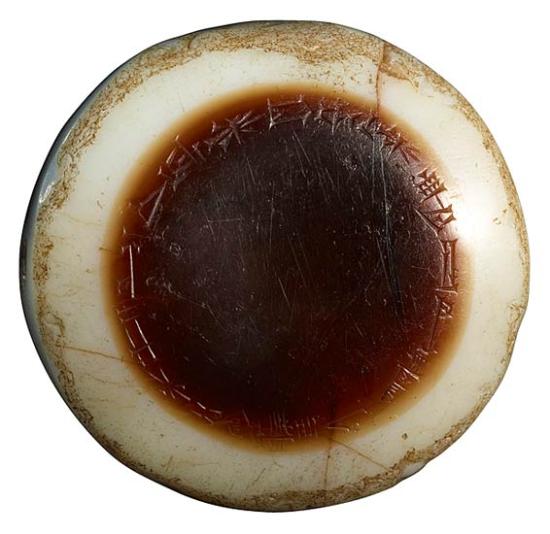
Eye Stone Amulet with a Dedication Inscription of King Nebuchadnezzar II in Akkadian
Inscribed: To Marduk, his lord, Nebuchadnezzar, king of Babylon, son of Nabopolassar, gave this for his life
Taking advantage of the stone's natural banding, agates were carved to resemble an eye. The votive inscriptions indicate the placement of the object on an altar or in a temple as a gift to a deity. The stones were thought to have some inherent power that would help protect the life of the person named in the inscription. These amulets probably adorned the cult statue of the god inscribed and were most likely worn in precious gold settings.
Nebuchadnezzar, whose name means "may (the god) Nabu protect the borders," was a great general, statesman, and builder with ambition and imagination, whose surviving monuments are without rival in Mesopotamia. The Babylon of Herodotus, including the Hanging Gardens, is largely the work of his architects.
The agate was found probably at Babylon, where Marduk was the patron god of the city.
Tablet Inscribed in Babylonian

Tablet Inscribed in Babylonian with a Ritual for the Observances of Eclipses
Lunar eclipses figured prominently in the prognostications of the Babylonian seer. This text was part of the temple ritual. Specific roles and chants are assigned to different types of priests and laypeople. Aromatic woods are to be burned on an altar throughout an eclipse; dirges are to be sung; people are to remove their headgear and cover their heads with their garments, then wail and cry aloud, begging the gods to save them, their cities, and their shrines. The text conceives of an eclipse as the "death" of the moon, of nature, and of man, and conjures their revivication.
As the eclipse begins, the... priest shall light the torch, and attach it to the altar... As long as the eclipse lasts, the fire upon the altar thou shalt not remove. A dirge for the fields thou shalt intone; a dirge for the streams that the water shall not devastate, thou shalt intone... As long as the eclipse lasts, the people of the land shall remove their headgear; they shall cover their heads with their garments. That catastrophe, murder, rebellion, and the eclipse approach not... they shall cry aloud; for a lamentation they shall send up their cry....
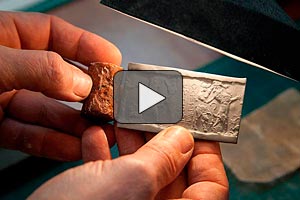
Between 1885 and 1908, the American clergyman and editor William Hayes Ward assembled a collection of 1,157 cylinder seals for Morgan's library. These tiny objects, no more than one inch in height, were carved with simple tools on semi-precious stones. The seals served to identify their owners and could be worn as amulets to bring good luck. Each cylinder seal is engraved with scenes that appear in relief when the seal is rolled out over clay. This vibrant example of Neo-Babylonian art of the seventh century BC is carved on carnelian, a brownish-red mineral that is used as a semi-precious gemstone. We are witnessing a heroic struggle between the superhuman hero at left and a ferocious lion, who are fighting over the bull. The victorious winged hero, with his sickle-sword behind him, places his left foot firmly on the bull's head, holding the animal's tail in his left hand. His opponent, the ferocious lion, raises his sharp claws in a demonic gesture. Despite the violence of the combat, the warring figures are stately, as if arrested in time. A constant theme in Mesopotamian art and religion, such battle dramas symbolized the struggle for world order against the forces of chaos. Here the conflict has been transposed from the natural world to the realm of the supernatural, symbolizing the enduring vigilance with which civilization must protect itself.